

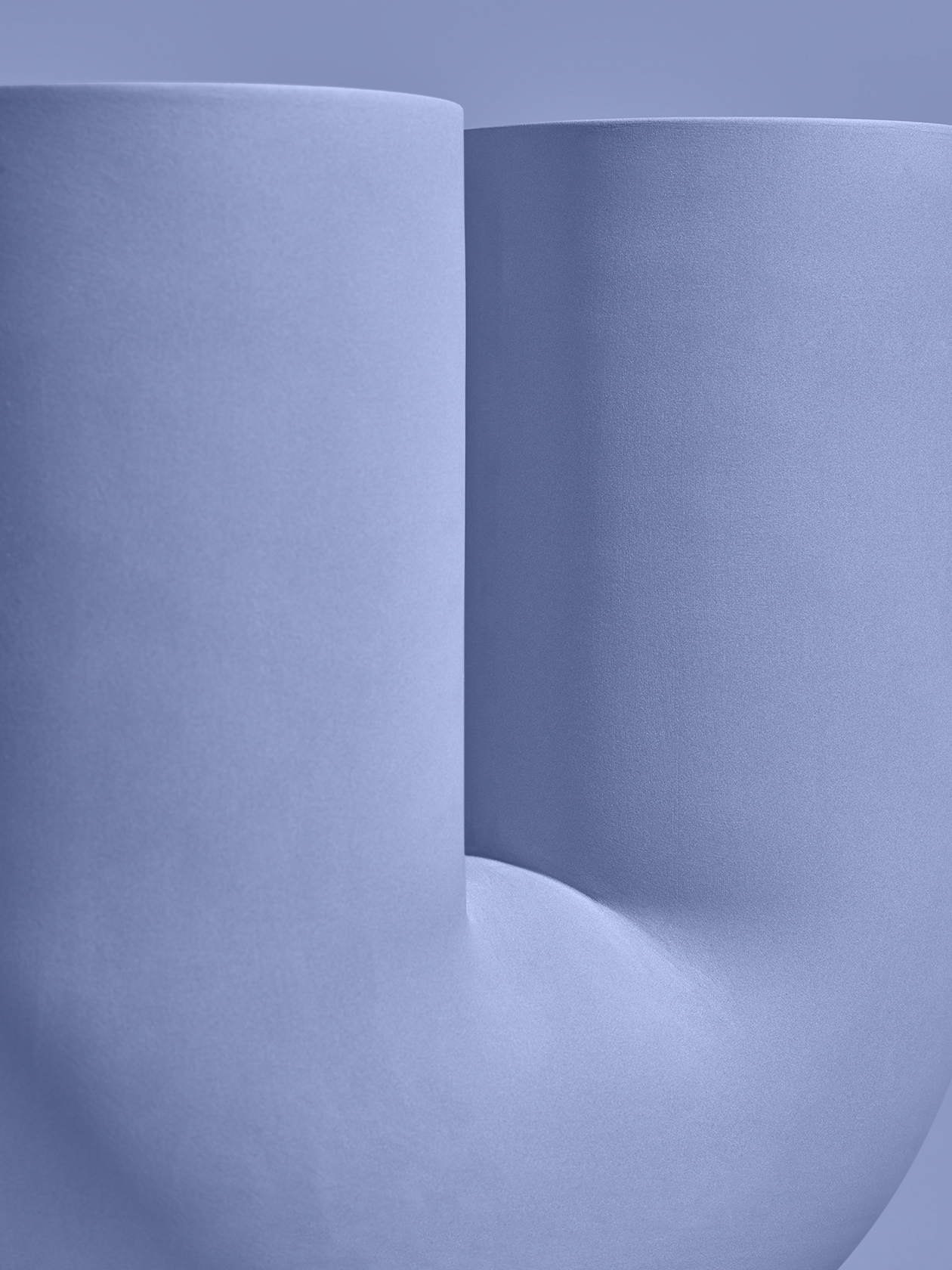
Kink
Vase
A double-mouthed vase named for the two sharp bends that create its suggestive, humanoid form. Produced in periwinkel blue and off-white porcelain.
2019
Client: Muuto
Concept: Rachel Griffin
Design and Development: Rachel Griffin
Photography: Pim Top
Press Downloads
Permalink
Buy






Recess
Modular Drawer
A system of modular drawers that takes inspiration from Shaker chests and built-ins. Each drawer is a separate unit that can be used individually, in stacks, side-by-side and/or on legs, with nesting forms holding the various elements in position. The repetition of a single base component allows for economy both in production and in use, while the shallow proportion is ideal for tidying and building out a wide variety of compositions. Produced in blue-black stained ash wood and matte, powder-coated steel.
2018
Client: Free to Edition
Concept: Rachel Griffin
Design and Development: Rachel Griffin
Permalink

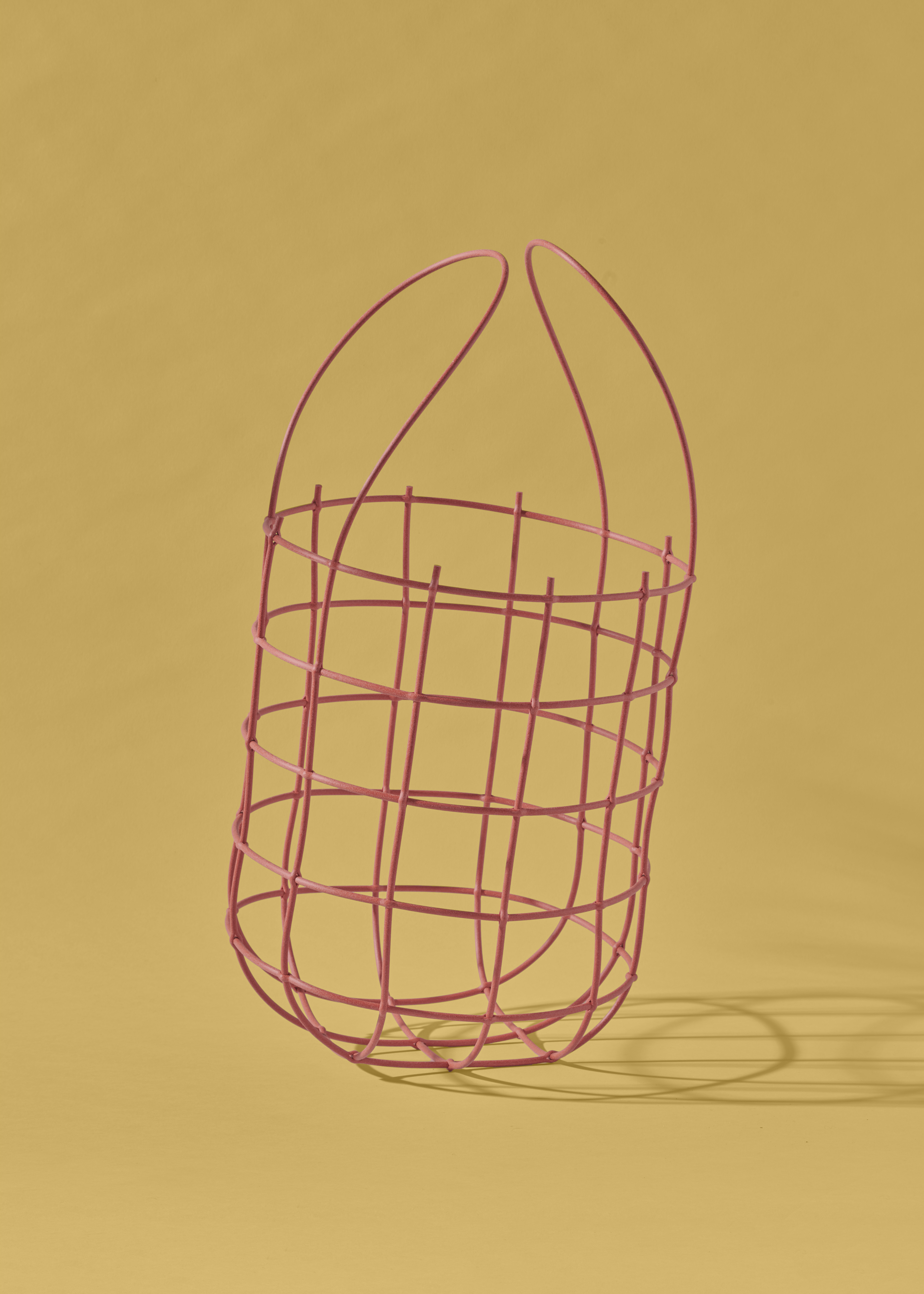


Cleft
Basket
Designed for sunny days at the beach, the “Cleft” basket has generous proportions and a large, open weave. Filaments are selectively split to create joints which are playful in form, but sturdy in function.
2021
Client: Basketclub x Dedon
Concept: Rachel Griffin
Design and Development: Rachel Griffin
Photography: Pim Top
Permalink









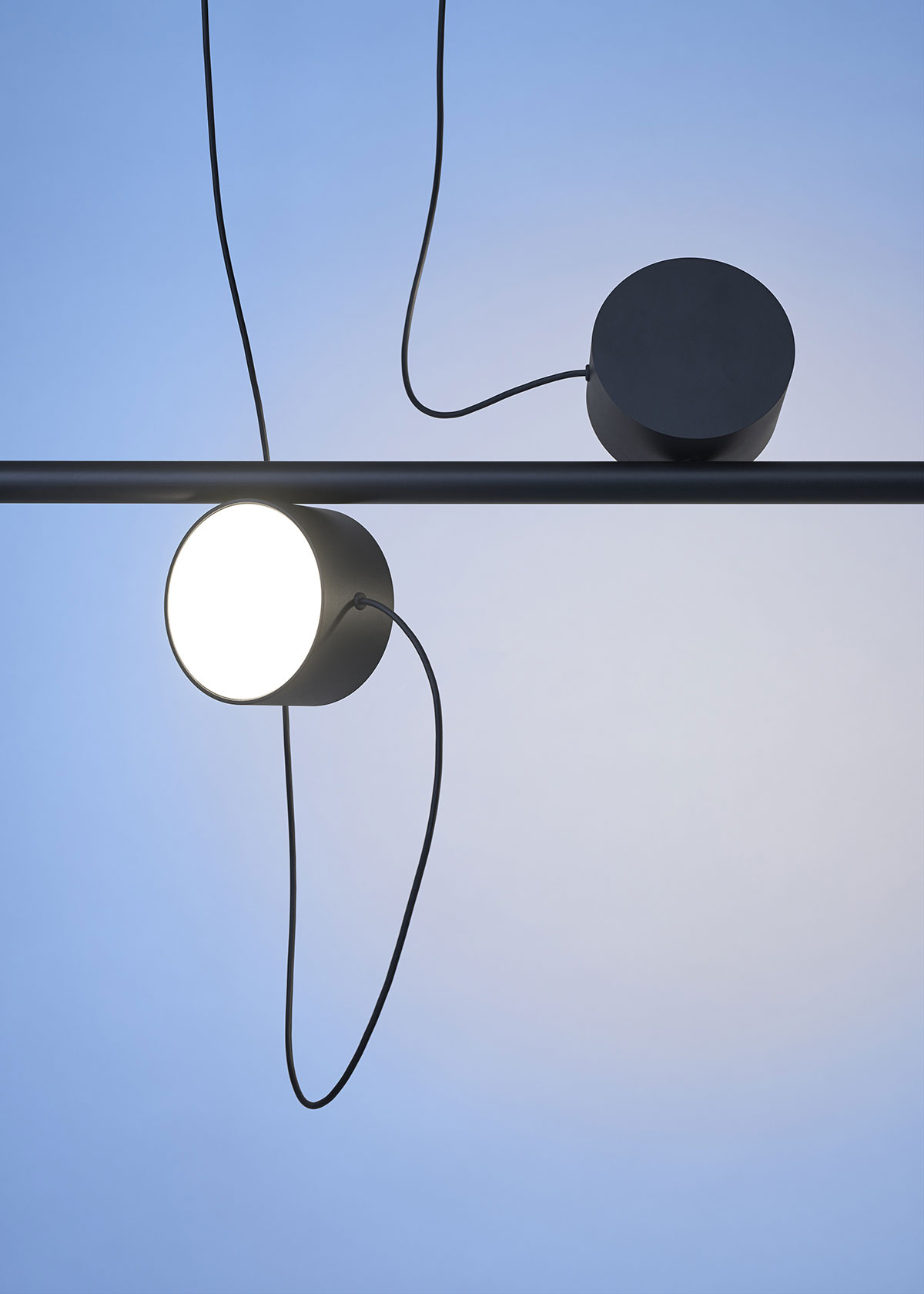
Post
Lamp Family
A series of lamps based on a single, independent, LED light source, which can be attached (alone or in multiples) to one of four cylindrical steel armatures, designed for the table, floor, ceiling and wall. The sources are fastened with a magnetic connection, which allows them to be arranged in an unlimited number of positions and orientations, with each combination producing a different function, composition and character.
2017
Client: Muuto
Concept: Rachel Griffin
Design and Development: Rachel Griffin
Assistance: Alex Sizemore
Photography: Pim Top
Press Downloads
Permalink

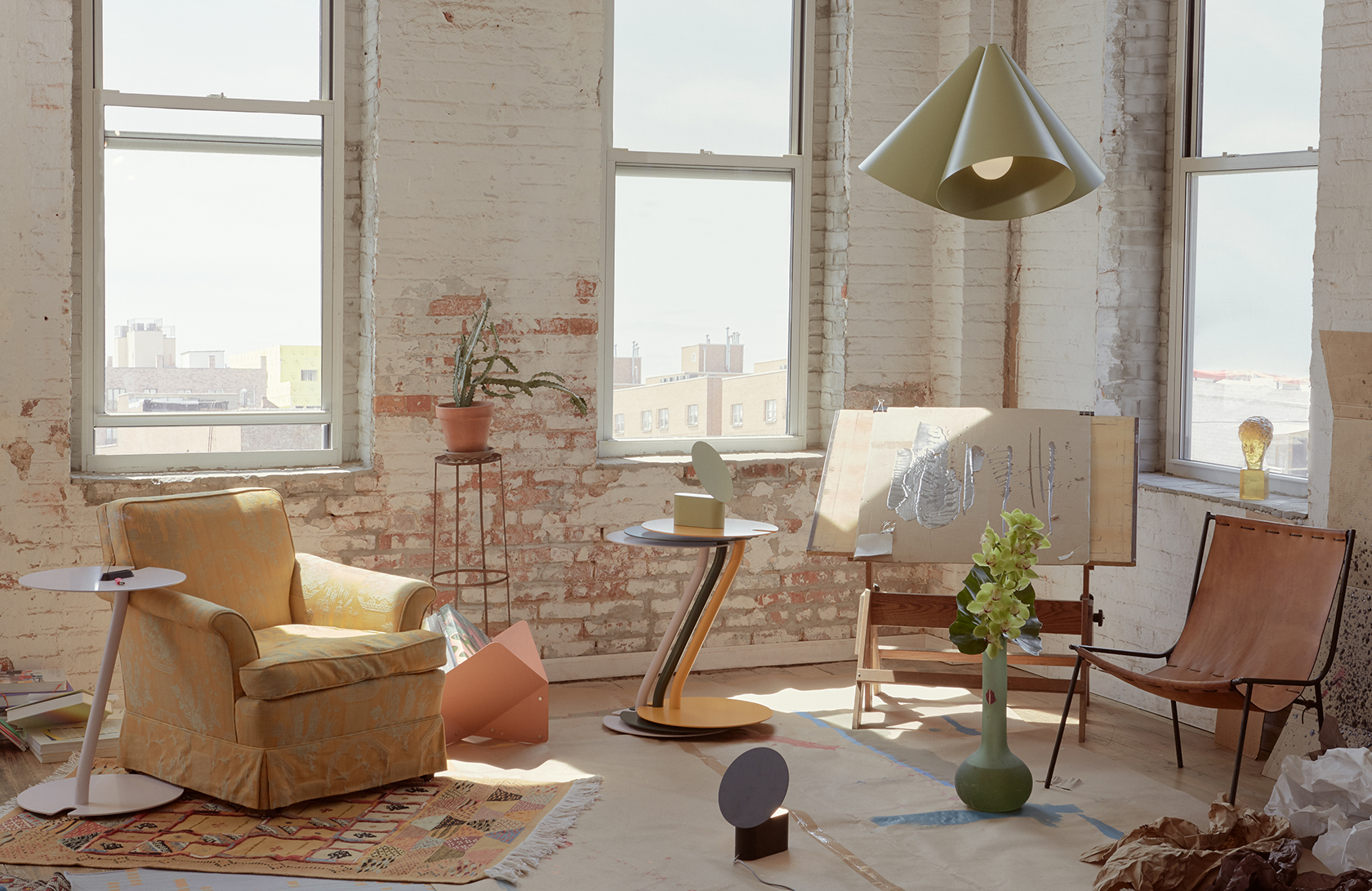
Clover
Pendant Lamp
A single spherical bulb intersects three conical shades to form the “Clover” pendant. The intersection creates new forms, and allows each of the three separate volumes to be illuminated by one, simple light source. The clover lamp is both bold and elegant in commercial and residential spaces alike.
2018
Client: Free to Edition
Concept: Rachel Griffin
Design and Development: Rachel Griffin
Press Downloads
Permalink



Loop
Casegood Collection
The “Loop” collection is a minimal, yet refined series, whose thin frame belies it's sturdy construction. This fine line has been achieved by “stepping back,” or tapering the front edge of each piece, to create a feeling of lightness without sacrificing durability. The series comprises two dressers, a cabinet and a bedside table.
2020
Client: Design Within Reach
Concept: Rachel Griffin
Design and Development: Rachel Griffin
Assistance: Renée Spanjer
Permalink
Buy



Mull
Candle Sconce
A candle sconce created with “gezelligheid” or cosiness in mind. The object is equally at home standing on a table or hanging on a wall, thanks to a folded base which wraps underneath the back of a curved shade to form a discreet hanging bracket. The shape is as soft and refined as the production is simple; laser-cut aluminium sheets are bent and notched together, and then fixed in place with a simple book screw. The sandblasted surface creates a reflective glow to warm any interior. Created in collaboration with Jonas Lutz.
2018
Client: Free to Edition
Concept: Rachel Griffin and Jonas Lutz
Design and Development: Rachel Griffin and Jonas Lutz
Photography: Pim Top
Press Downloads
Permalink
Buy

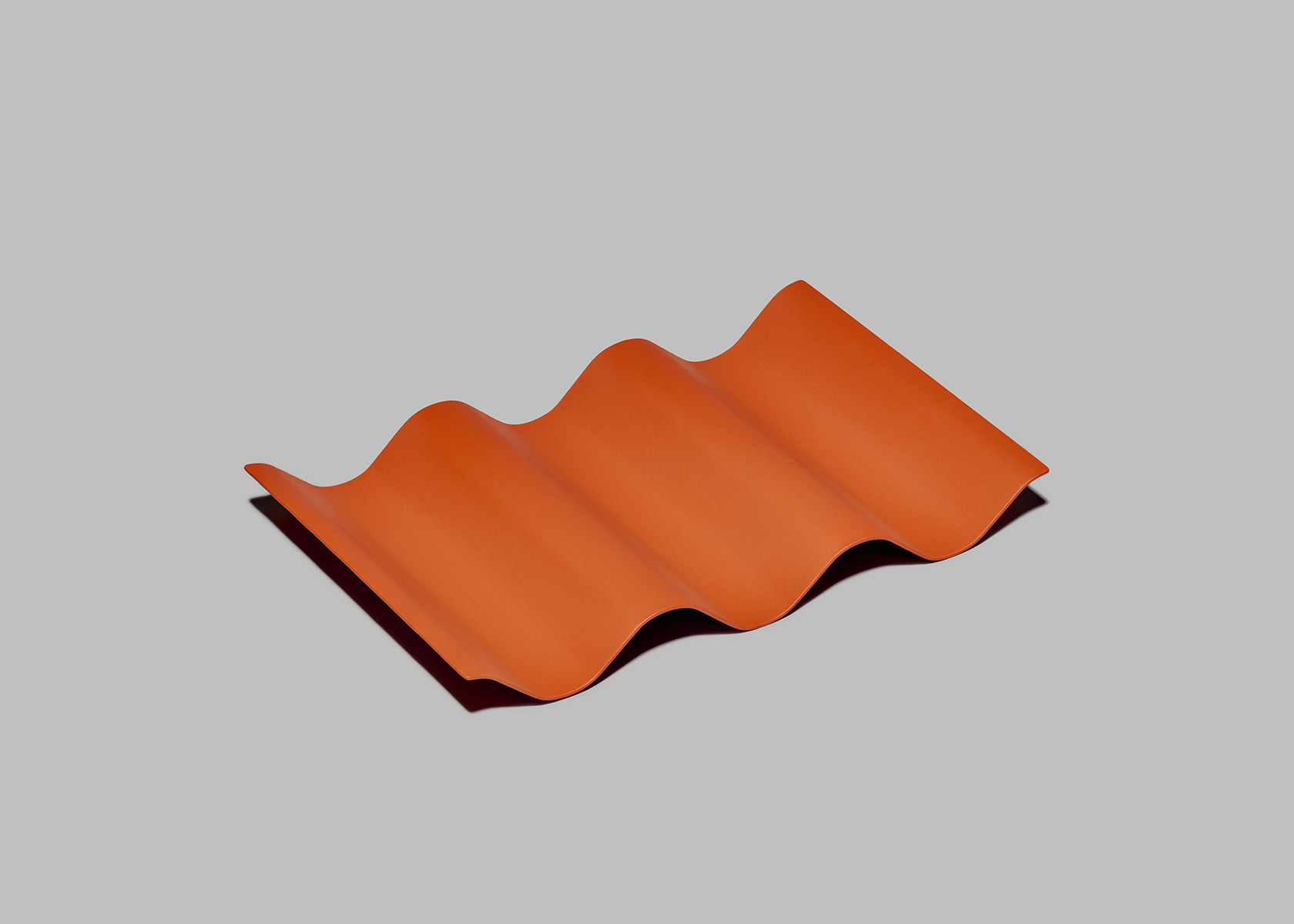

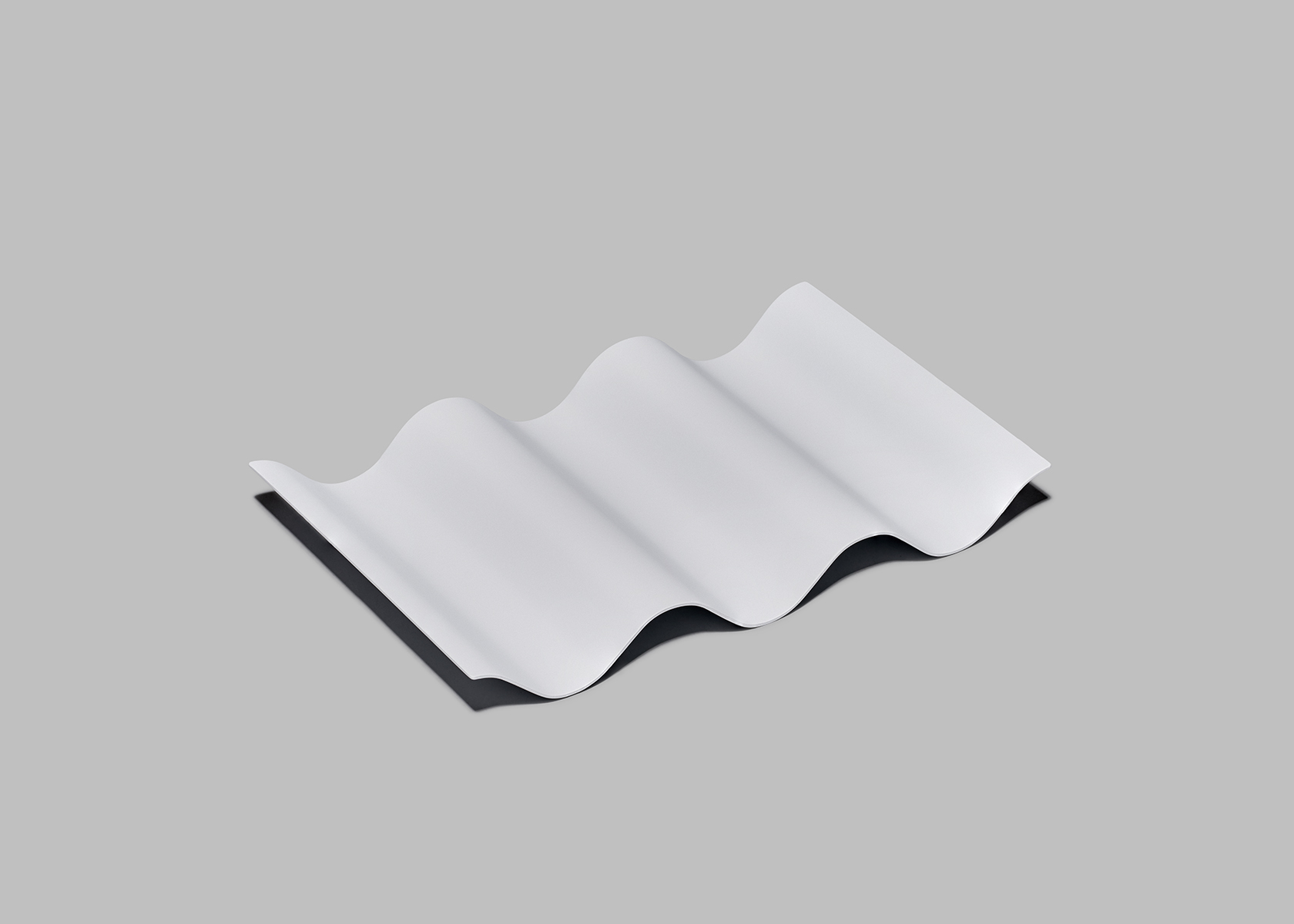


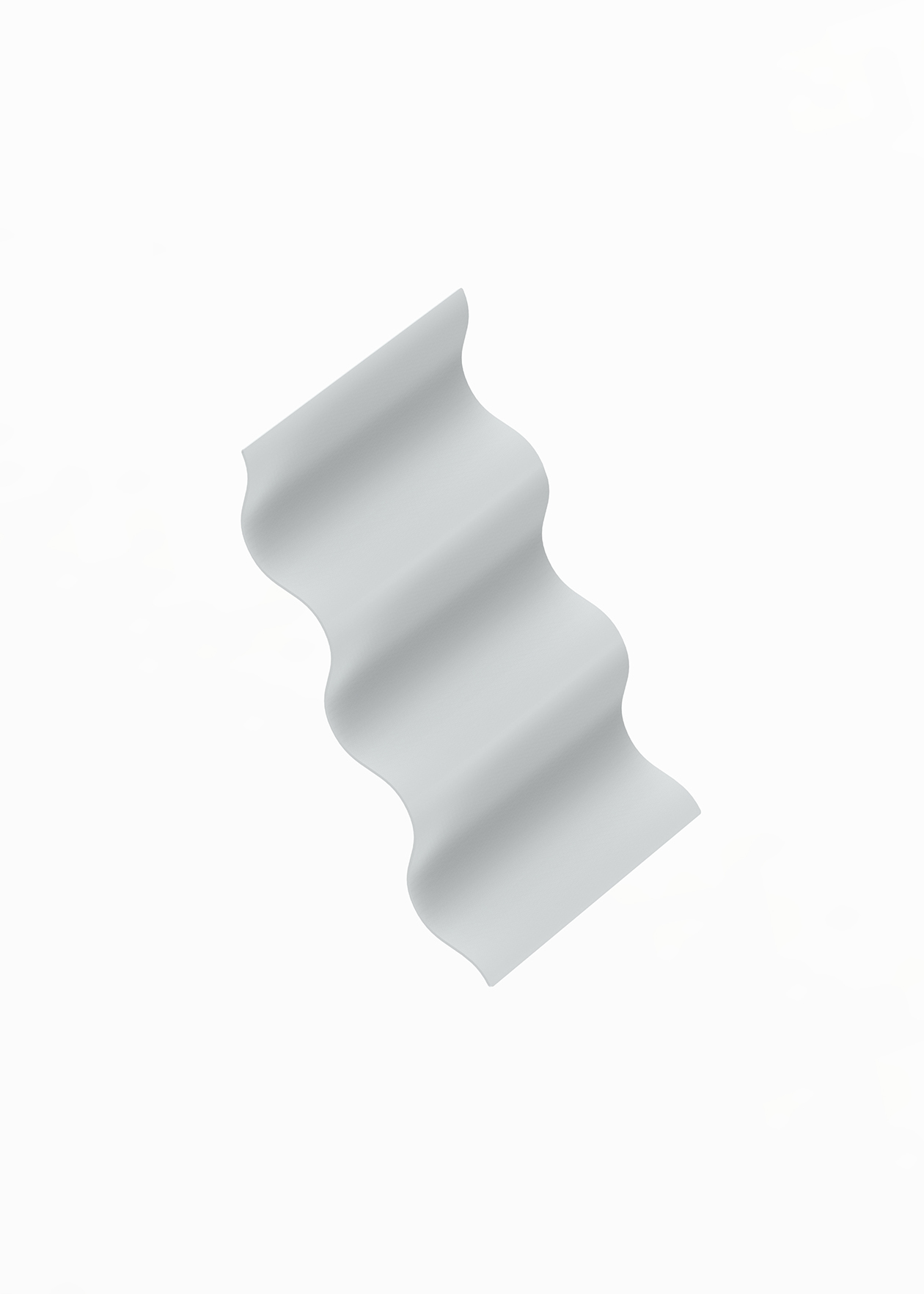
Wavy
Trays
A series of nesting trays designed to hold loose pocket change and tabletop sundries. Produced from corrugated aluminium sheets, its graphic ripple form is both playful and practical, creating separate compartments for storage and organisation.
2018
Client: Free to Edition
Concept: Rachel Griffin
Design and Development: Rachel Griffin
Photography: Pim Top
Press Downloads
Permalink
Buy



Nick
Shaving Brush and Bowl
A shaving set whose simple, intersecting forms result in a small notch where the brush can rest horizontally, like a cigar in an ash tray. Produced from sandblasted aluminium, the material creates an optical effect and a tension between two and three dimensions. Commissioned by Good Thing and Harry’s for their New York Design Week exhibition “A Brush With Design.”
2017
Client: Good Thing and Harry’s
Concept: Rachel Griffin
Design and Development: Rachel Griffin
Assistance: Alex Sizemore
Photography: Alex Sizemore
Permalink


Strand
Hanging Rail
A hanging rail whose simple construction allows it to float in front of the wall. In addition to the left and right movement afforded by most rail systems, the space between the wall and the object creates additional functionality and flexibility; scarves, towels or hangers can be hung over the backside, pivoting hooks can catch and release against the wall under weight, and mirrors can swivel up and down under the compression of a thumb screw. Produced in blackened ash wood, tinted mirror, and matte, powder-coated steel.
2017
Client: Free to Edition
Concept: Rachel Griffin
Design and Development: Rachel Griffin
Assistance: Alex Sizemore
Press Downloads
Permalink

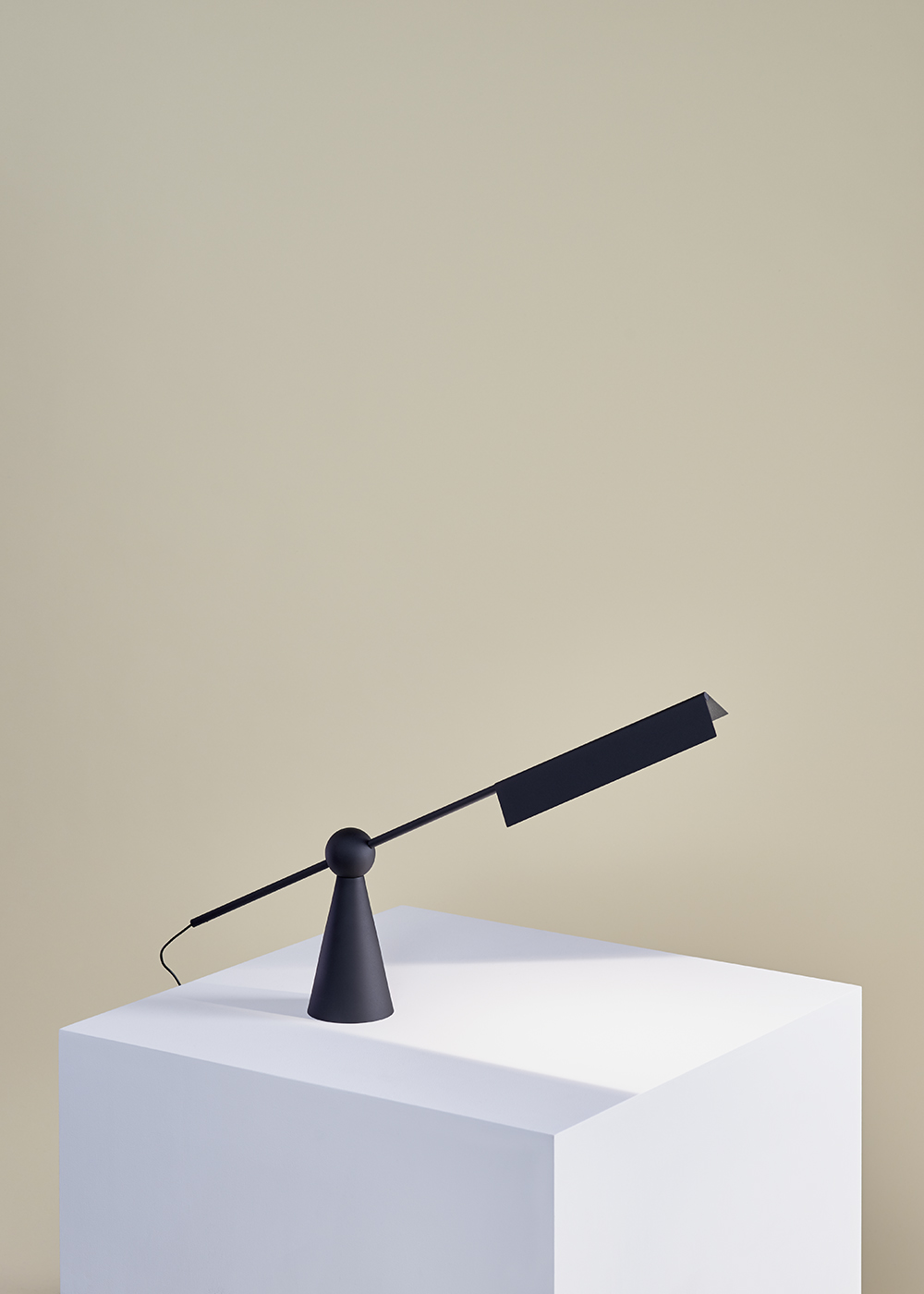





Mill
Table Lamp
Inspired by the dexterity of the basic sphere, “Mill” is a movable table lamp that maintains its position using balance. Just two components—a ball, resting on a cone—combined with gravity, create an open joint that affords the lamp an exceptionally wide range of motion. Mill uses energy efficient LEDs and is powered by a low-voltage USB connection. Nominated for the German Design Award 2017.
2016
Client: Free to Edition
Concept: Rachel Griffin
Design and Development: Rachel Griffin
Assistance: Camille Fraslin
Photography: Pim Top
Press Downloads
Permalink

Deuce
Pitcher/Watering Can
A pitcher that invites you to share leftover drinking water with your houseplants. Two spouts encourage two functions: small and rounded for pouring water into glasses; long and thin for reaching through leaves. When filling your glass, the long spout doubles as a handle; when feeding your plants, the circumference fits comfortably in the hand. Created in collaboration with Emilie Pallard. More images coming soon!
2016
Client: Umbra Shift
Concept: Rachel Griffin and Emilie Pallard
Design and Development: Rachel Griffin and Emilie Pallard
Photography: Umbra Shift
Permalink








Range
Wall Hanging System
Taking inspiration from the traditional french cleat, “Range” is a flexible wall hanging system that allows multiple objects to be fastened in an unlimited number of configurations, using one simple rail. Comprising hooks, shelves and a mirror, the series is versatile enough to be used in a variety of domestic settings, such as the hallway, the bathroom or the bedroom.
2016
Client: Free to Edition
Concept: Rachel Griffin
Design and Development: Rachel Griffin
Assistance: Camille Fraslin
Photography: Pim Top
Press Downloads
Permalink

Pare
Candlestick
The traditional candlestick, pared down to it’s most essential elements. A subtle curve in a simple sheet creates the candle and finger grip in one easy gesture.
2016
Client: Free to Edition
Concept: Rachel Griffin
Design and Development: Rachel Griffin
Assistance: Camille Fraslin
Photography: Pim Top
Press Downloads
Permalink





Revolve
Floor Lamp
“Revolve” is an ambient floor lamp which uses weight and pressure to maintain its posture. A heavy marble base anchors the object in place, while the lamp repositions on the frame under the compression of a thumb screw. Created in collaboration with Emilie Pallard.
2015
Client: Bolia
Concept: Rachel Griffin and Emilie Pallard
Design and Development: Rachel Griffin and Emilie Pallard
Photography: Pim Top
Press Downloads
Permalink


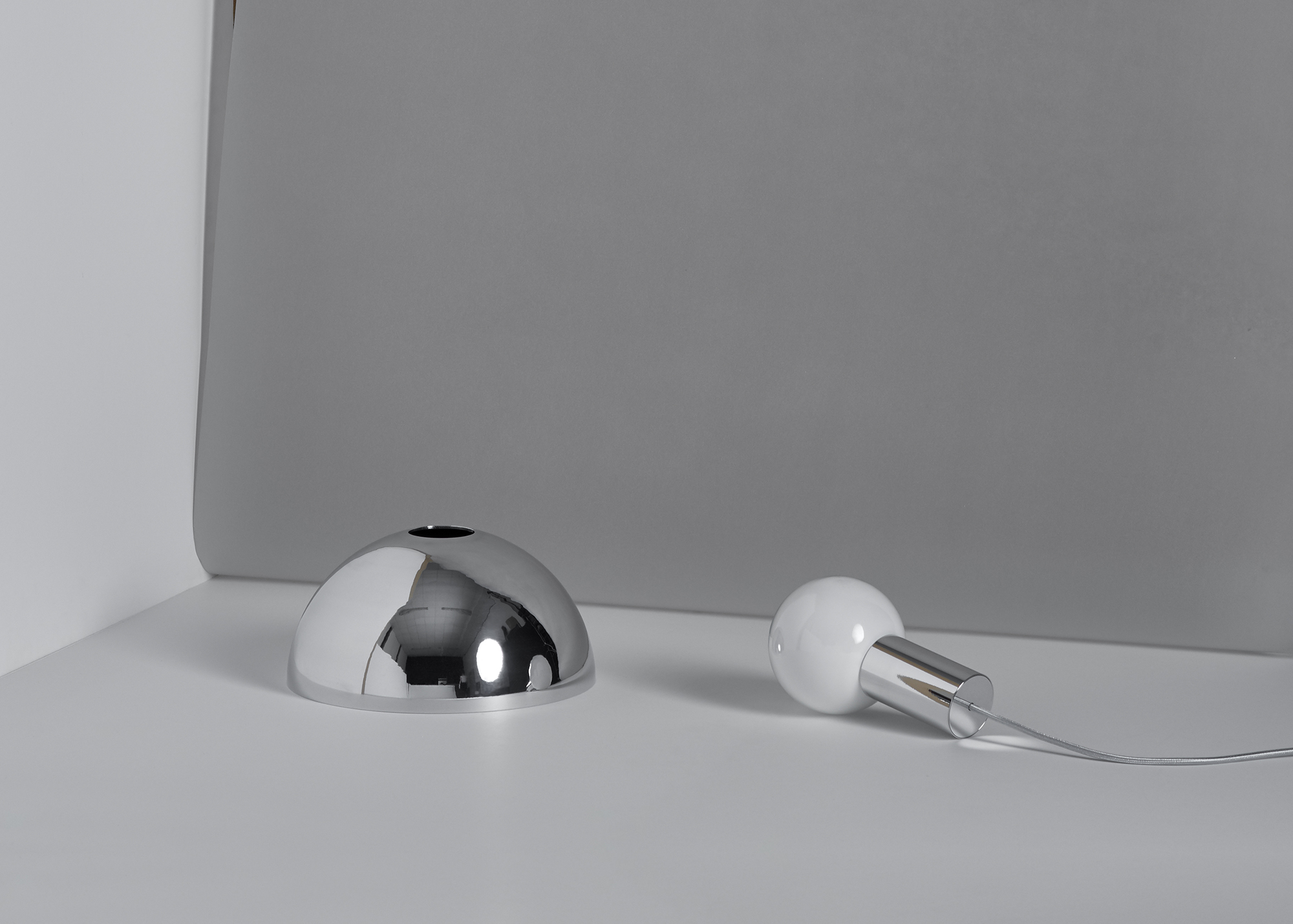
Topsy
Pendant Lamp
“Topsy” is a lamp whose light can be adjusted by simply flipping the shade. Constructed from loose components, the shade rests lightly on the bulb and can be positioned facing up or down, allowing the mirror-finish to either diffuse or concentrate the light.
2015
Client: Free to Edition
Concept: Rachel Griffin
Design and Development: Rachel Griffin
Photography: Pim Top
Press Downloads
Permalink
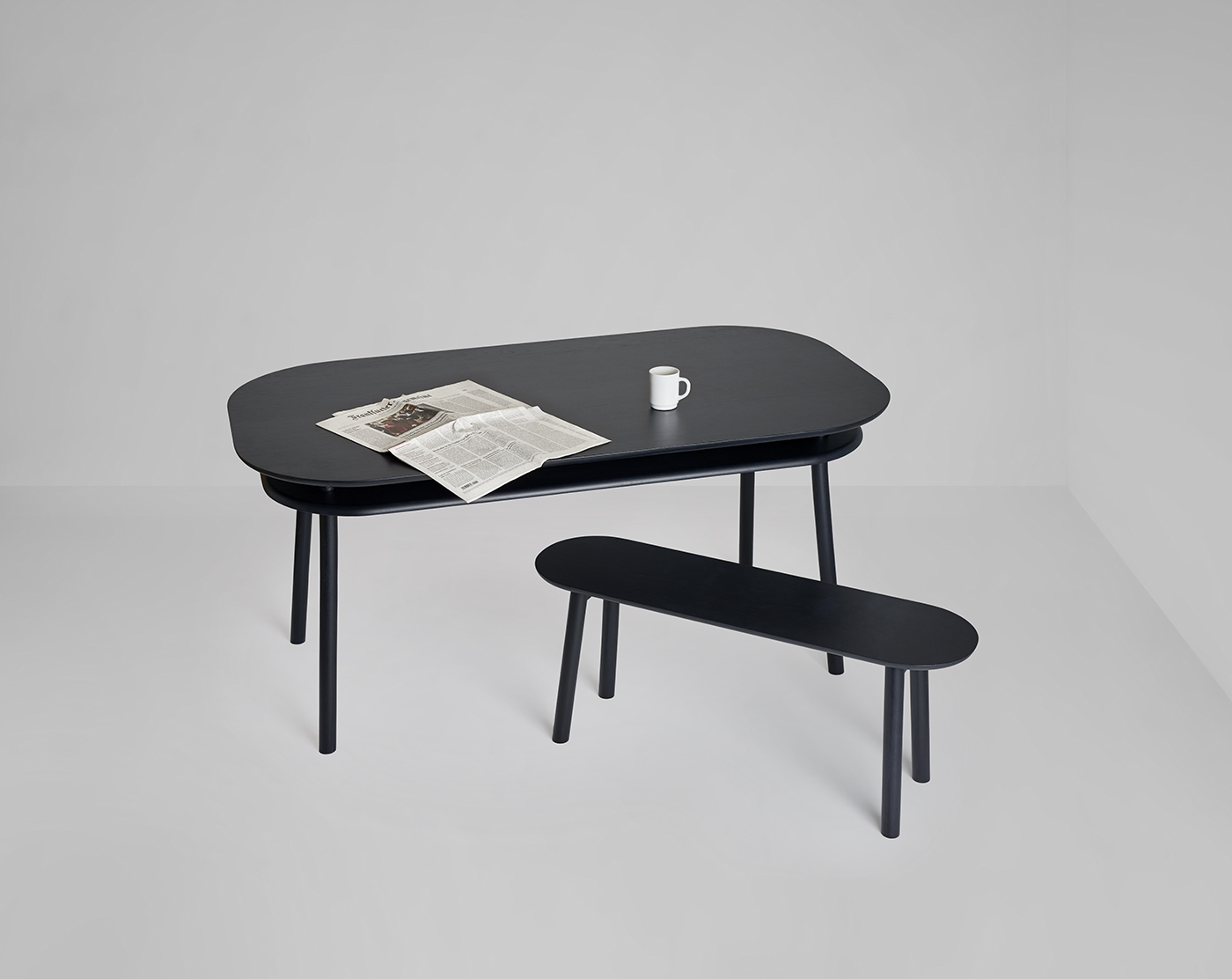




Stow
Table
In small spaces, surfaces are a precious commodity; tables are used for multiple activities, such as dining, serving, display, play and work. The “Stow” table is designed for such flexible use. A second surface creates a low storage where small objects–laptops, books, napkins or other sundries–can be tucked away while the top surface is used for an alternate function.
2015
Client: Schoenbuch
Concept: Rachel Griffin
Design and Development: Rachel Griffin
Assistance: Camille Fraslin
Photography: Pim Top
Press Downloads
Permalink


Drum
Side Table
“Drum” is a simple, geometric form, whose graphic qualities play with the boundary between a two- and a three-dimensional object. Its cylindrical shape is multifunctional, serving as a side table or small storage.
2015
Available Through: Colony
Concept: Rachel Griffin
Design and Development: Rachel Griffin
Photography: Pim Top
Press Downloads
Permalink








Couple
Trivets
“Couple” is a series of concentric trivets produced from thin slabs of natural stone. Each set is made from one piece, preserving the natural patterns of the material like the pieces of a puzzle.
2015
Client: Free to Edition
Concept: Rachel Griffin
Design and Development: Rachel Griffin
Photography: Pim Top
Press Downloads
Permalink



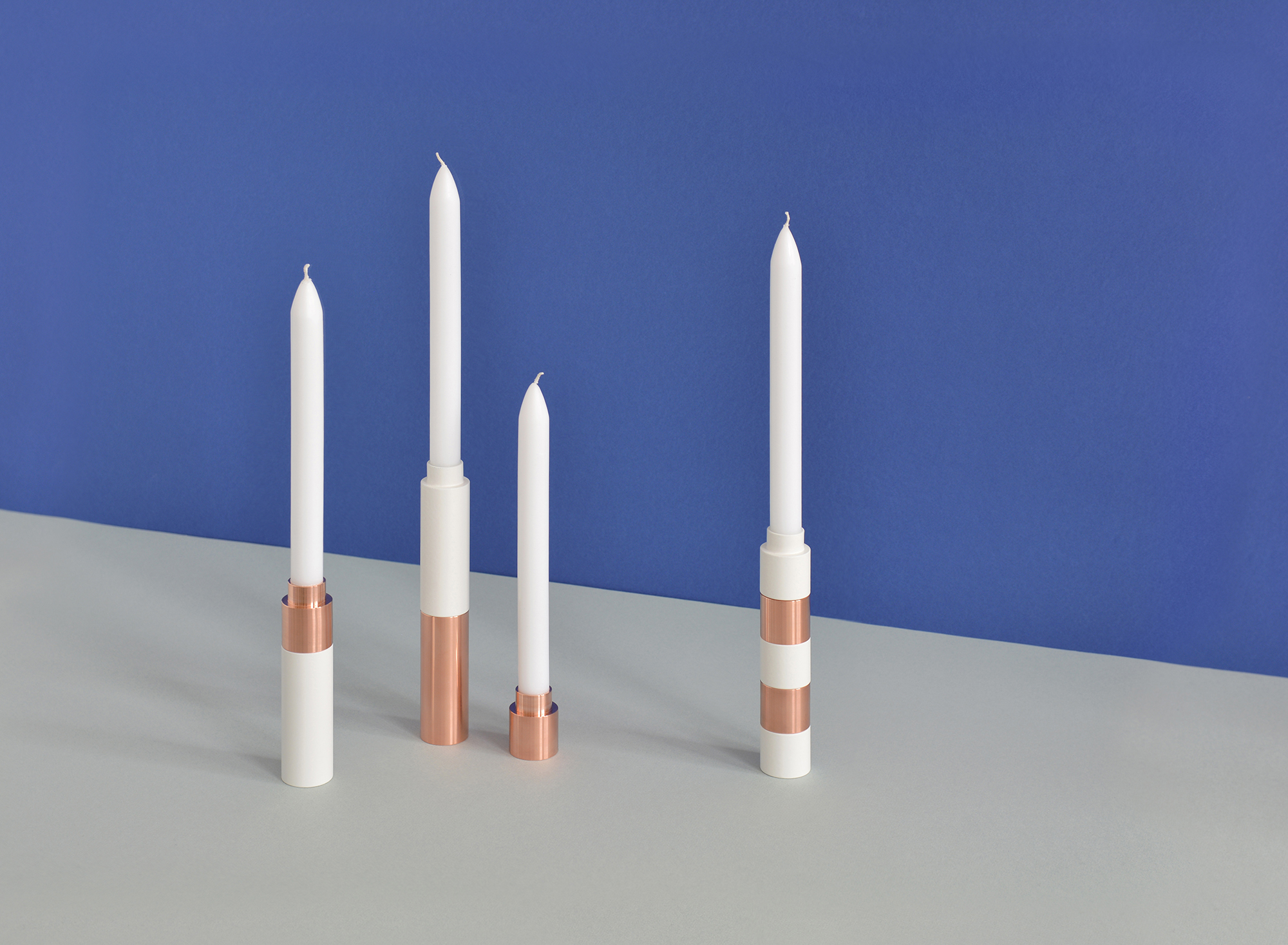




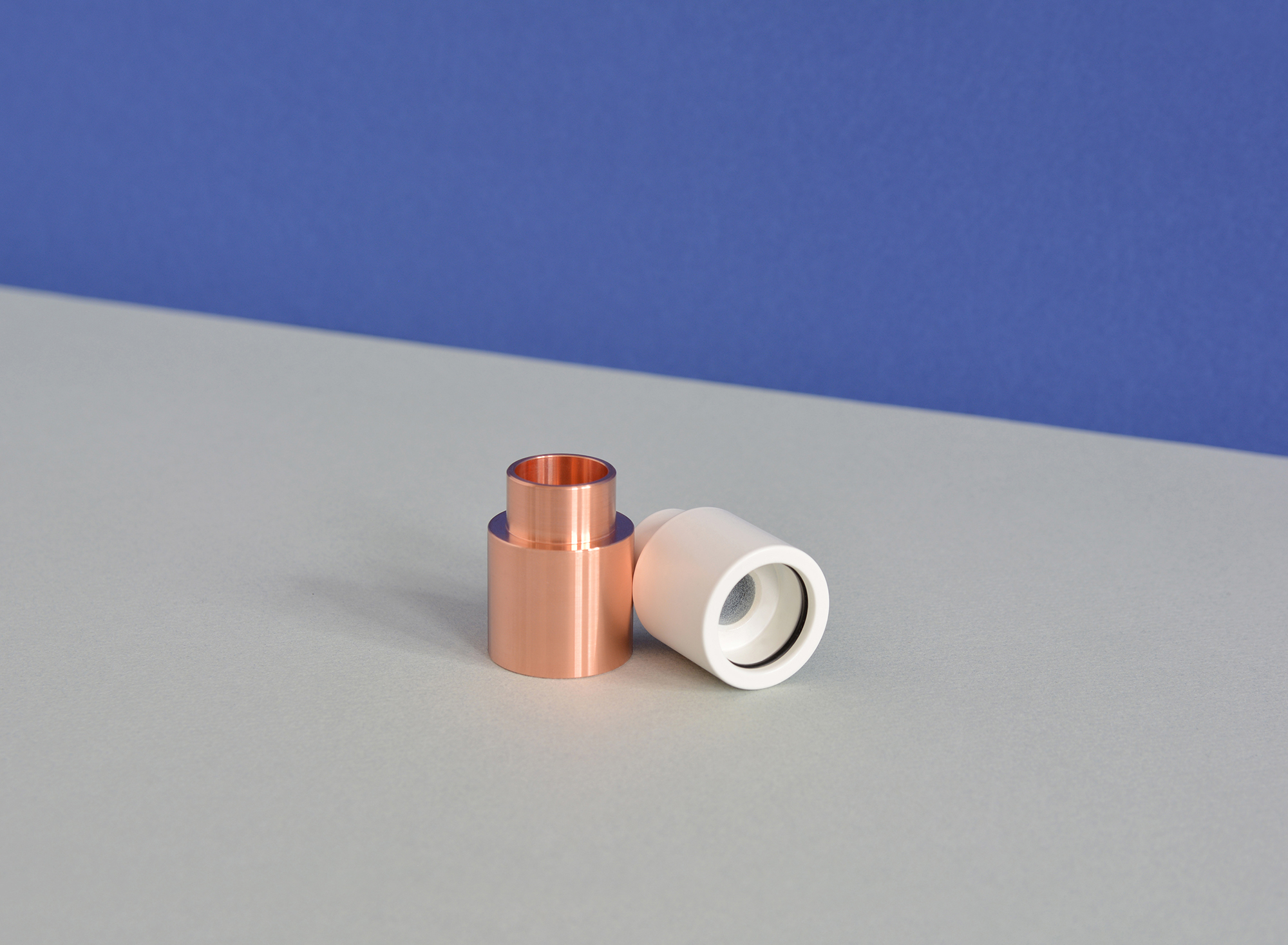
Stack
Modular Candleholders
“Stack” is a series of modular candleholders. Each module is fitted with an o-ring on the interior, allowing the various parts to pressure-fit together. Produced in two different heights (46 and 110 mm) and three different finishes (white, blue-black and copper), the six different modules can be combined in an infinite number of combinations to construct a functional and graphical centrepiece.
2014
Client: Free to Edition
Concept: Rachel Griffin
Design and Development: Rachel Griffin
Photography: Rachel Griffin
Press Downloads
Permalink







Fragment
Tableware
The natural stone industry produces a large amount of waste, in the form of slurry, dust and larger offcuts. A portion of this waste is recycled for use in other industries, while the rest is transported to landfills at great expense. However, many such rough pieces have a beauty all their own and need not be discarded. “Fragment” is a series of bowls and lids produced from such rough pieces; the unique shape, colour and texture of each segment determines the look and function of the result. Ranging in diameter from 75 to 250 mm, “Fragment” vessels offer a range of uses, from a vide-poche to a fruit bowl.
2014
Available Through: Earnest Studio
Concept: Rachel Griffin
Design and Development: Rachel Griffin
Photography: Pim Top
Press Downloads
Permalink


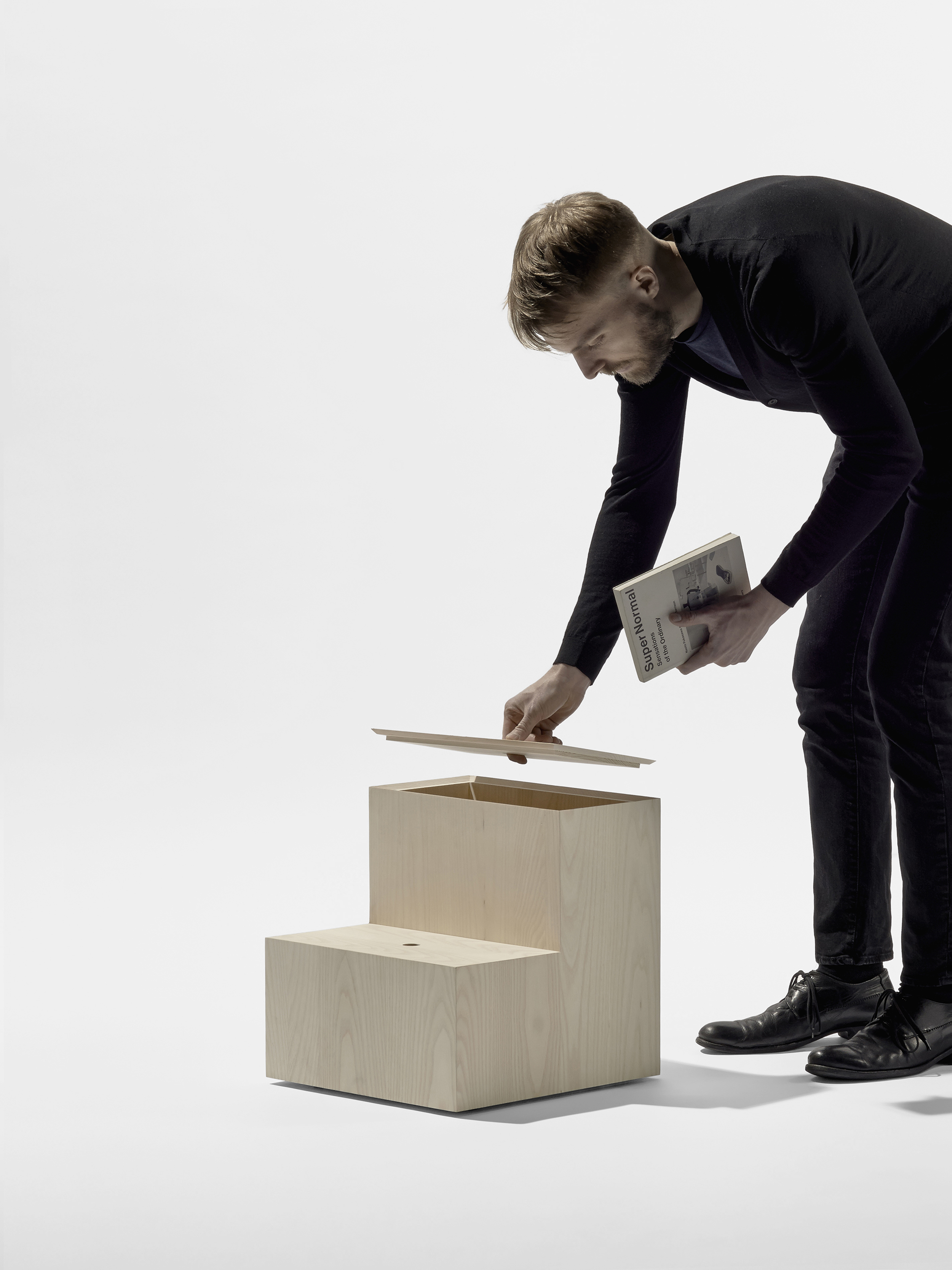
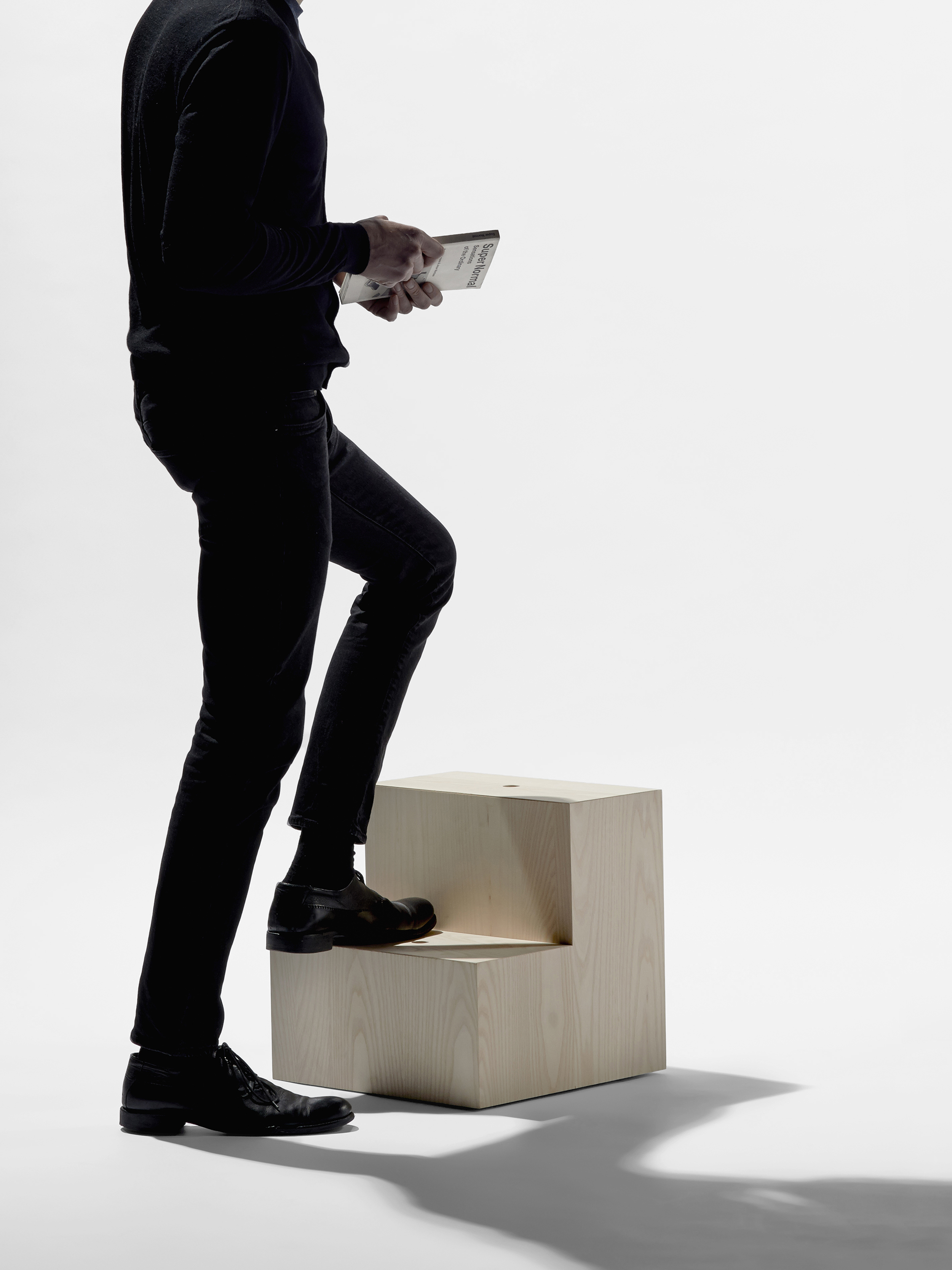

Stair Case
Stepstool
The “Stair Case” is both a stair and a case; a rolling step stool combined with storage. Equipped with spring-loaded wheels, the “Stair Case” is a floating architectural element that can roll from place to place in the home or office. When stepped upon, it sinks to the ground, becoming a stable flight of stairs that can be used to reach a light bulb or a high shelf. Meanwhile, unsightly sundries can be stowed beneath its two removable lids.
2014
Client: Free to Edition
Concept: Rachel Griffin
Design and Development: Rachel Griffin
Photography: Pim Top
Press Downloads
Permalink



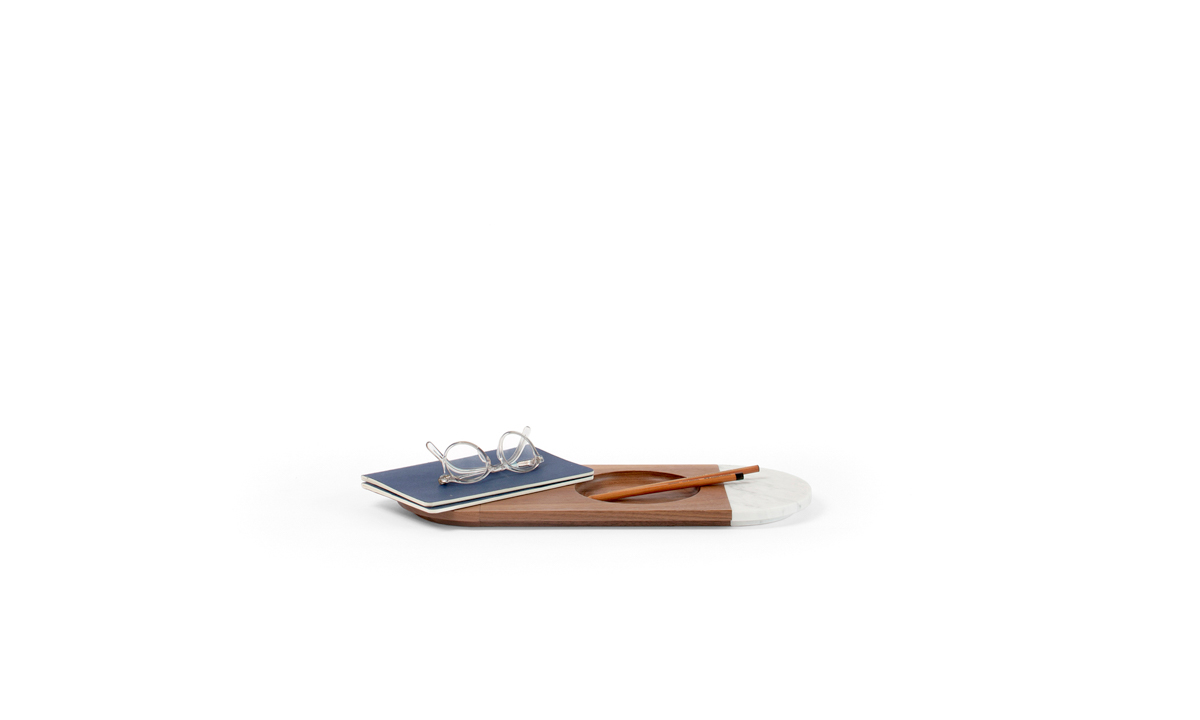
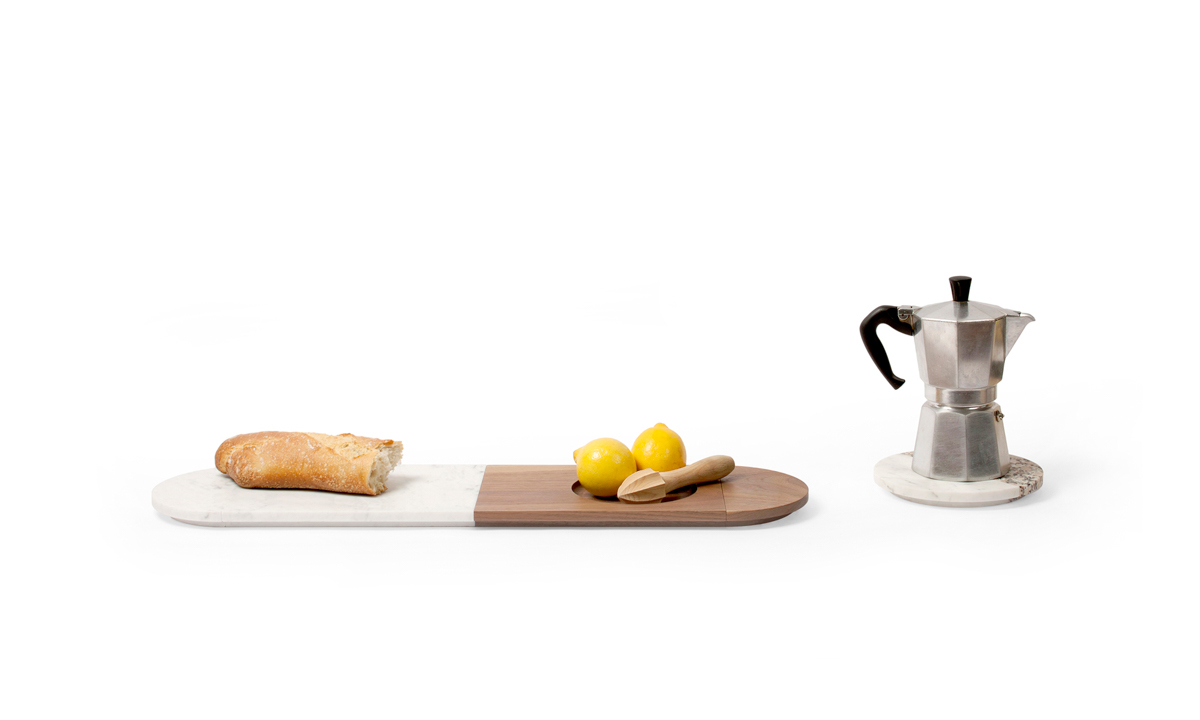
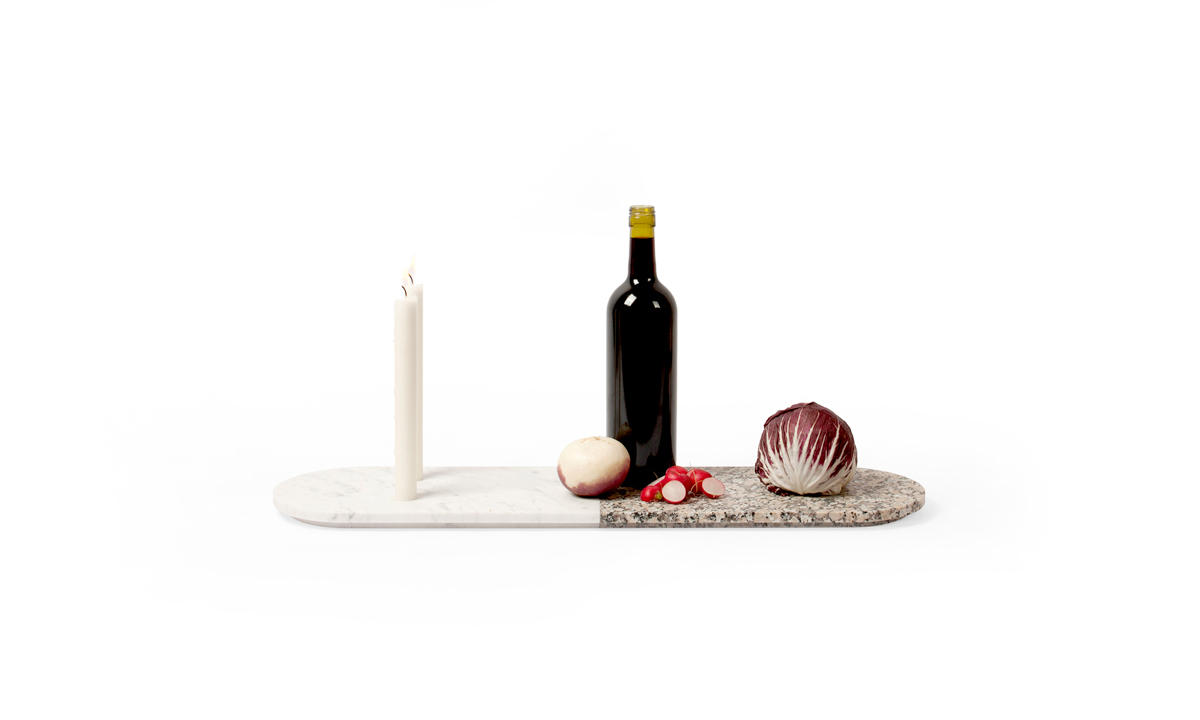



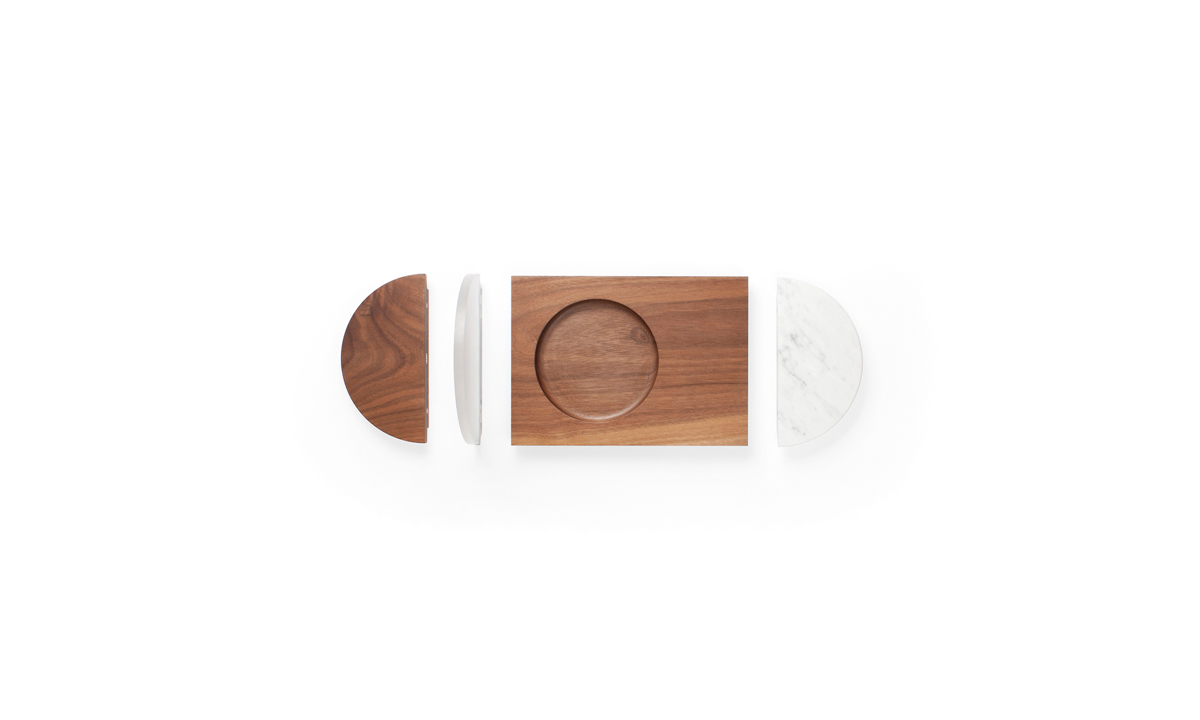


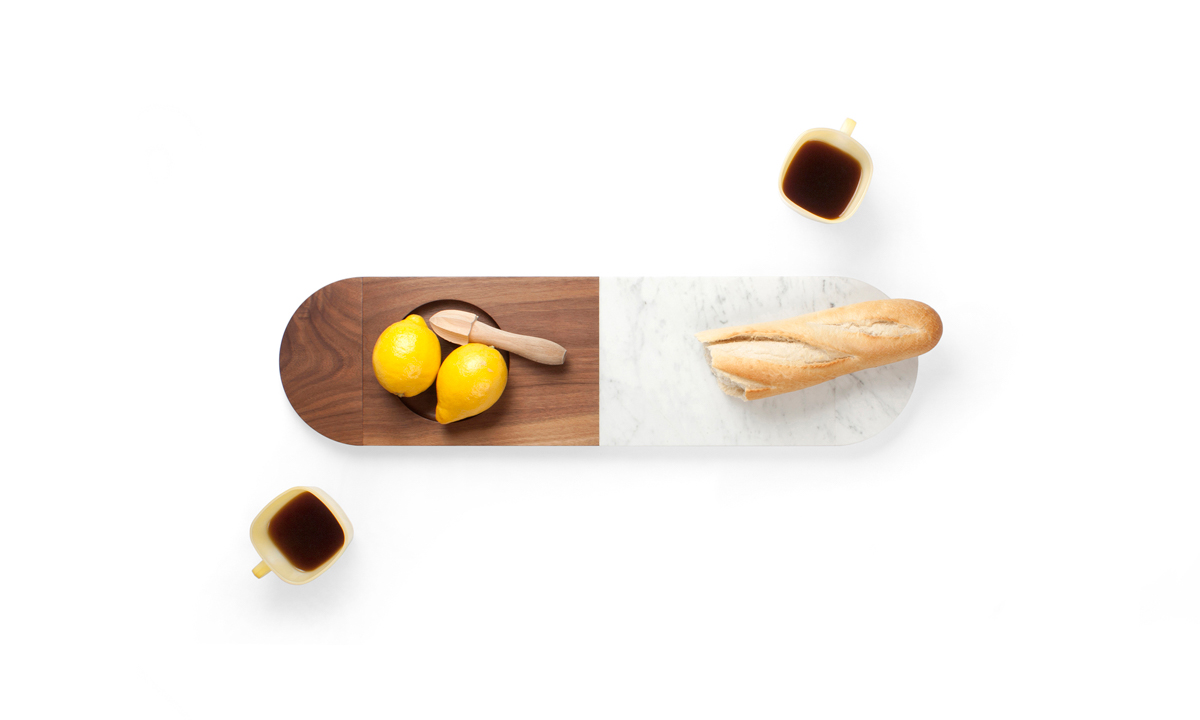

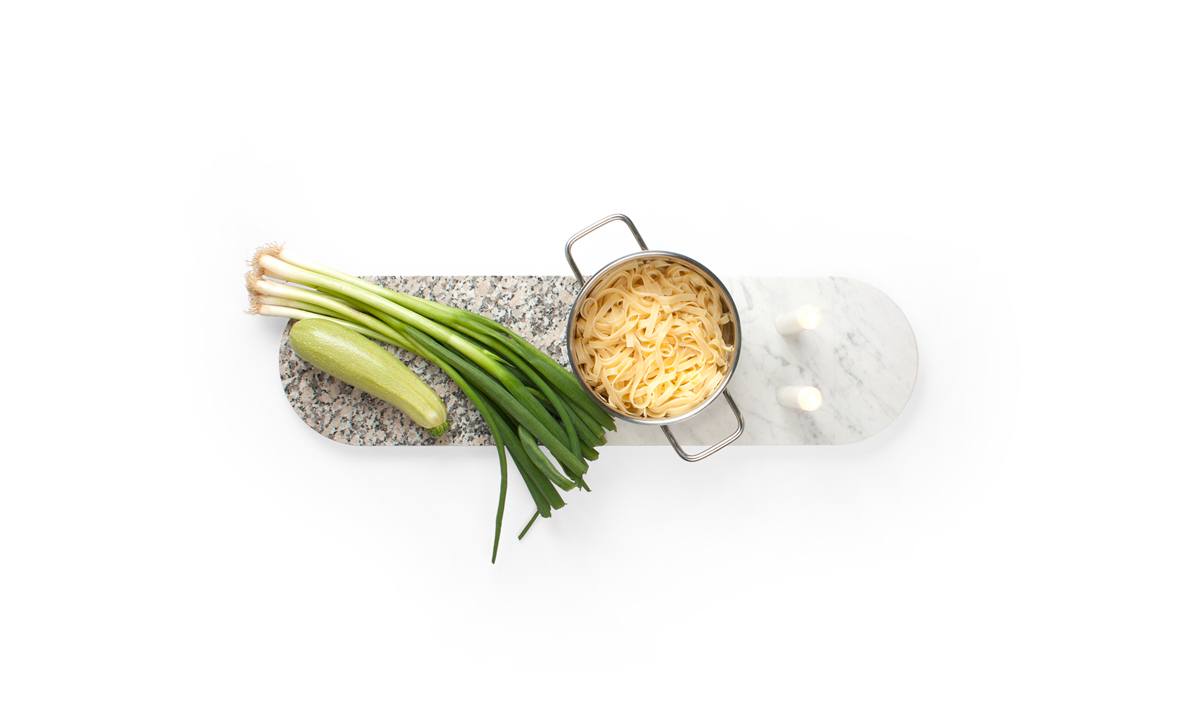


All of a Piece
Modular Tableware
“All of a Piece” is a series of modular tabletop elements that, combined, form landscapes of varying materials, sizes and functions. The series comprises a flat tray, a shallow bowl, a candleholder and an endcap, each made of marble, granite, and wood. Materials and forms can be interchanged depending on a user’s needs, from the smallest trivet, to the largest dining table centerpiece. A fifth part–an LED light–can be inserted between modules, adding atmosphere and utility to every arrangement. To see the pieces in use, watch the video. “All of a Piece” is a collaboration between Earnest Studio and Dana Cannam Design. Nominated for the German Design Award 2016.
2013
Available Through: Earnest Studio
Concept: Rachel Griffin and Dana Cannam
Design and Development: Rachel Griffin and Dana Cannam
Production: Earnest Studio
Photography: Rachel Griffin and Dana Cannam
Press Downloads
Permalink





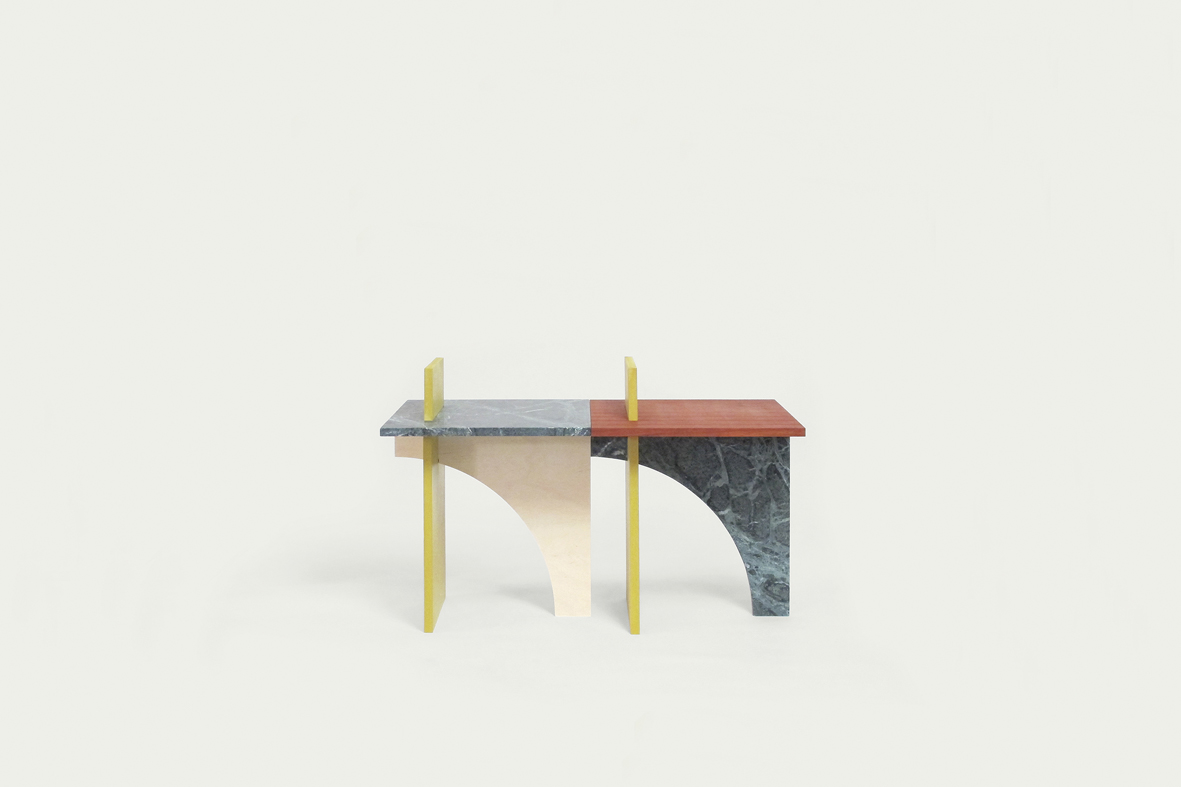











Face Value
Modular Tables
“Face Value” is a series of low tables, each made of three interlocking panels. Each panel is produced from a range of materials–marble, Corian, Padoek hardwood, coloured MDF, and plywood–representing a range of values. These materials (and values) are then assembled to create tables in varying compositions of texture, colour and cost. The tables can be used in many configurations; individually, in a line or stacked as shelving.
2013
Client: Free to Edition
Concept: Rachel Griffin
Design and Development: Rachel Griffin
Photography: Rachel Griffin
Press Downloads
Permalink

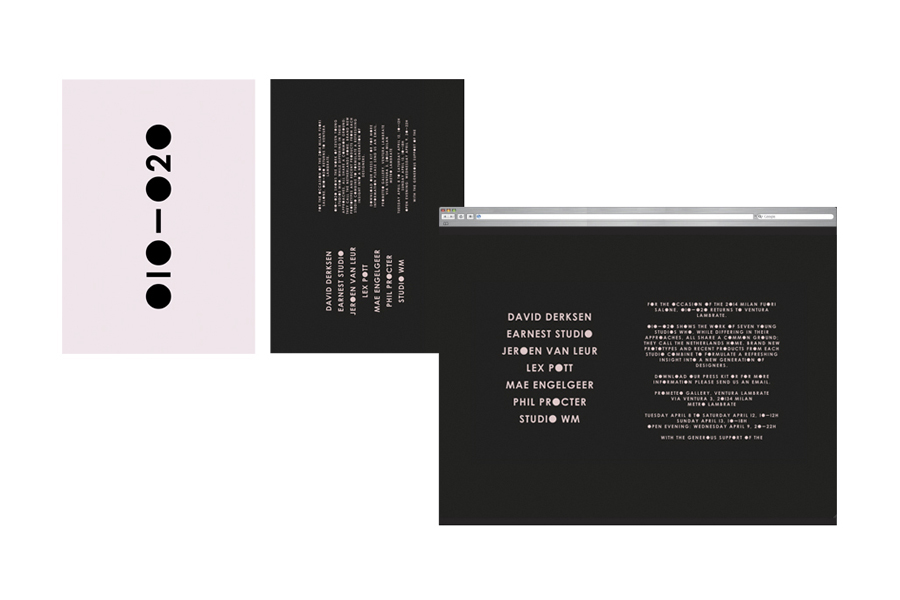
010-020
Identity, Print Collateral and Website
A visual identity, print collateral and website for the exhibition 010-020 in Milan’s Ventura Lambrate.
2013
Concept: Rachel Griffin
Design and Development: Rachel Griffin
Press Downloads
Permalink












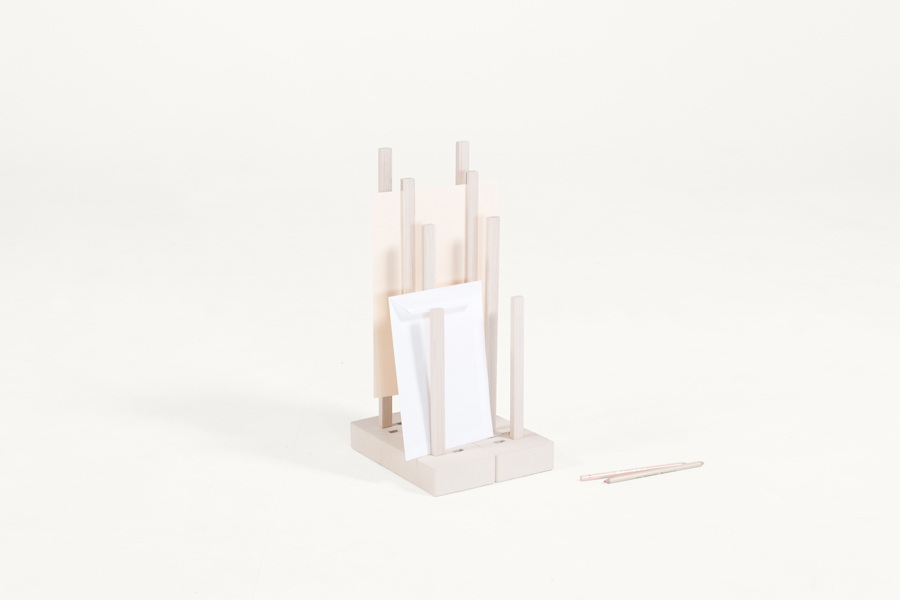

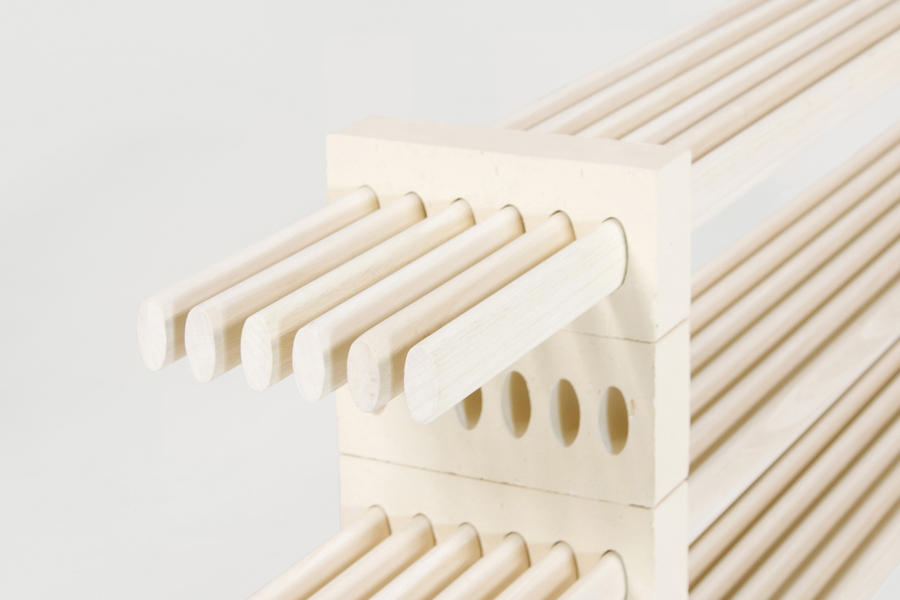

Building
Furniture Series
Made of perforated bricks and wood, “Building” aims to reinterpret exterior construction materials for use in the interior.
Each object in the collection uses the weight of the bricks as an anchor, while the wooden components are threaded through the existing perforations to tie the structure together. The results are an abstract, but functional range. The pieces are designed to be monochromatic, with the natural colours of the wood complementing the colours of the brick. “Building” is a collaboration between Earnest Studio and Emilie Pallard.
2012
Available Through: Earnest Studio
Concept: Rachel Griffin and Emilie Pallard
Design and Development: Rachel Griffin and Emilie Pallard
Photography: Rachel Griffin and Emilie Pallard
Press Downloads
Permalink
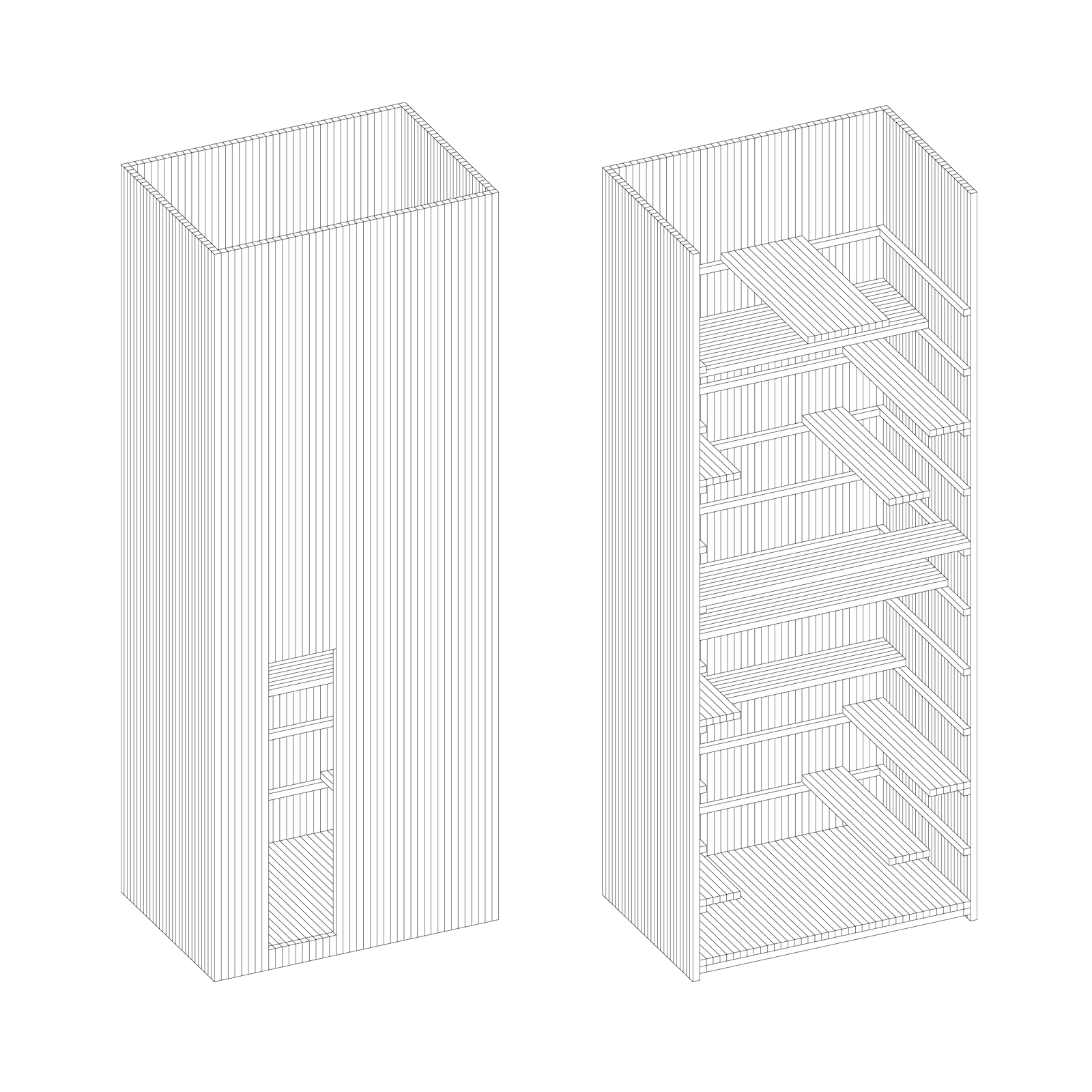






Bergen Safehouse
Urban Folly
A multi-purpose folly, built by Max Rink, Rachel Griffin and Simon de Jong during a 4-day competition in Bergen, Norway. A monument to Bergen's venerable history of city fires, the exterior of the structure uses the protective qualities of burnt wood, while the interior consists of moveable platforms that can be used for eating, working and socialising, and moving vertically through the space.
2012
Client: Bergen International Wood Festival
Concept: Rachel Griffin, Max Rink and Simon de Jong
Design and Development: Rachel Griffin, Max Rink and Simon de Jong
Press Downloads
Permalink
Open Design: a History of the Construction of a Dutch Idea
Introduction: Of Visibility and Productivity
As a design academic and a design practitioner, we are interested in open design. Like many involved, we recognize it as a movement with enormous social and economic potential. However, from our vantage points, we have noticed some disparity between the open talk and the open action. To better understand the prevailing realities of open design, this paper examines the confluence of distinct interests in the construction of open design discourse.
The phrase ‘open design’ has become ubiquitous in the Dutch design world. Its ascension to the top of the official agenda has been relatively rapid, advancing from a series of lesser-known activities to a lynchpin in the national design rhetoric in just three years. Its propagation has not remained confined to subcultural interest groups, but has spilled over to mainstream design discourse; this year it has been present, if not prominent, at nearly all major Dutch design events. Open design was an important theme of the Dutch contingent at the International Furniture Fair in Milan, Waag Society’s open design programme was nominated for the Rotterdam Design Prize (‘the “king” of Dutch Design prizes’) and this very publication – the first special edition on Dutch design in an international academic journal – focuses on ‘openness’, testifying to the centrality and implicit association of this term with design from the Netherlands. Justifiably, some commentators have raised the question as to why open design has become so prominent in this country in particular (see Menichinelli, 2011).
Transformations of this scope and speed do not occur by accident, so it is pertinent to enquire what factors contributed to its rapid emergence and widespread propagation in the Netherlands. Open design is commonly described as the development of physical products through the free sharing of information. As in the free and open source software movements before it, the internet facilitates the sharing of data, allowing other individuals to copy or evolve the original object. Although ‘free’ mostly refers to the freedom to copy, according to Wikipedia – arguably an authoritative reference in this context – open design ‘is often performed without monetary compensation’ (2012). This pool of shared data forms the commons, a body of information freely available for public use. Thus, where once methods of production were highly centralized in large, hierarchical corporations, this data-sharing coupled with new technologies proposes a new decentralized, grassroots, bottom-up production model.
In the Netherlands “open design is still very much in the idealistic phase” (Mulder, 2012); still “under construction” (Neicu, 2010: 30). This means that currently, the term open design points to an ideal rather than an extensive or coherent body of practices. But if the prominence of this ideal is not a reflection of widespread practices, why and how has it gained such currency?
Between 2009 and 2012 a series of highly visible events concerning open design were staged in the mainstream Dutch design arena. The first, the (Un)limited Design Contest, occurred in April 2009. Its result, as assessed by one of its initiators, was nothing less than to place ‘the idea of open design on the map in the Netherlands’ by the second half of that year (Waag Society, 2010: 9, authors’ translation). Its success led to a second edition of the competition with the slightly changed title (Un)limited Dutch Design in 2010, and to a third the following year. Other open design-related events included the digital platform-cum-collection Design for Download/MakeMe in 2010 and the publication of Open Design Now in 2011. These events were initiated by a small group of Dutch cultural organizations who, despite distinct and at times conflicting agendas, nevertheless had a common goal in fostering open design practices in the Netherlands. Crucially, they were all largely run with funding from the Ministry of Culture, Education and Science (Ministerie van Onderwijs, Cultuur en Wetenschap, OCW).
Thus, although open design is commonly associated with grass- roots, bottom-up activities, in the Netherlands the most visible effort at widespread dissemination of these ideals has been the result of a highly centralized effort largely supported by government funding. Why were the government and cultural organizations interested in fostering open design practices? And what type of open practices has this top-down model engendered? These are the questions this paper will address.
Taking our cue from Phillips and Hardy (2002), insofar as the above-mentioned interrelated contests, lectures, workshops, web- sites and publications bring a common notion into being, they may be thought of as together constituting a discourse on open design. Advancing from a constructivist epistemology, in this article we examine how the production and dissemination of this discourse has produced and given meaning to open design practices. These processes need to be viewed in relation to Dutch cultural policy on the one hand, and to the economic and political circumstances that served as catalysts in the formulation of this policy on the other. We will focus on three government-funded events that were key in the construction of open discourse in the Netherlands: (Un)limited Design Contest, (Un)limited Dutch Design and Design for Download. By examining how each participates in the construction of open design discourse, the aim is to tell the story of where the ideal of open design came from, why it gained such a foothold on the mainstream Dutch design stage and the implications its widespread dissemination has had in engendering open design practices.
Read More




Mass
Identity, Print Collateral and Website
A visual identity, print collateral and website for the exhibition Mass: 10 Designers on Methods, Material and Manufacturing. All images are duotone, putting the focus on the material and texture of the process images displayed in the background. makingmass.com.
2011
Concept: Rachel Griffin
Design and Development: Rachel Griffin
Press Downloads
Permalink

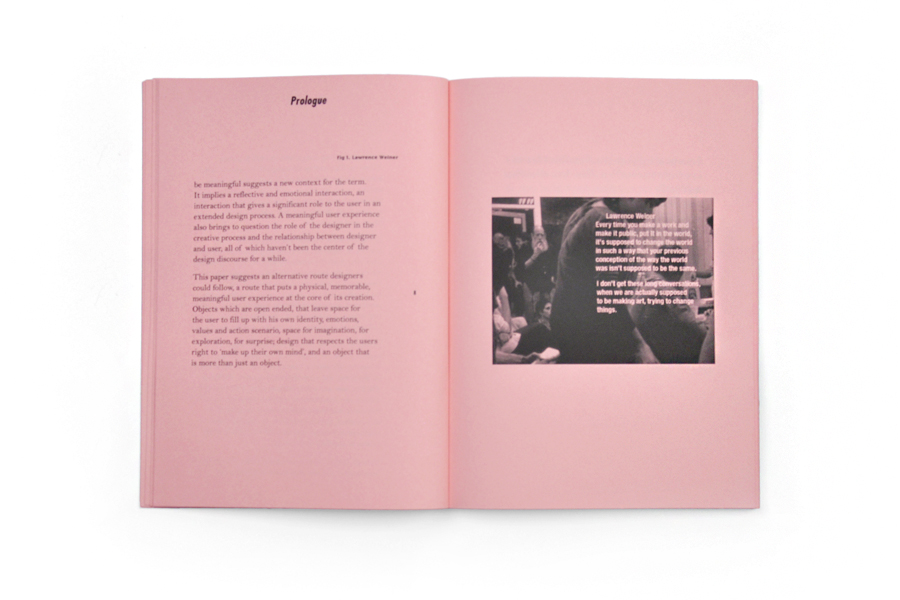






A Means to No End
Book
A design for a series of essays about product design from the perspective of user experimentation, play and interaction. The design of the book reflects these ideas through the choice of a playful paper colour and dramatic shifts in scale and grid.
2010
Client: Saron Paz
Concept: Rachel Griffin
Design and Development: Rachel Griffin
Press Downloads
Permalink

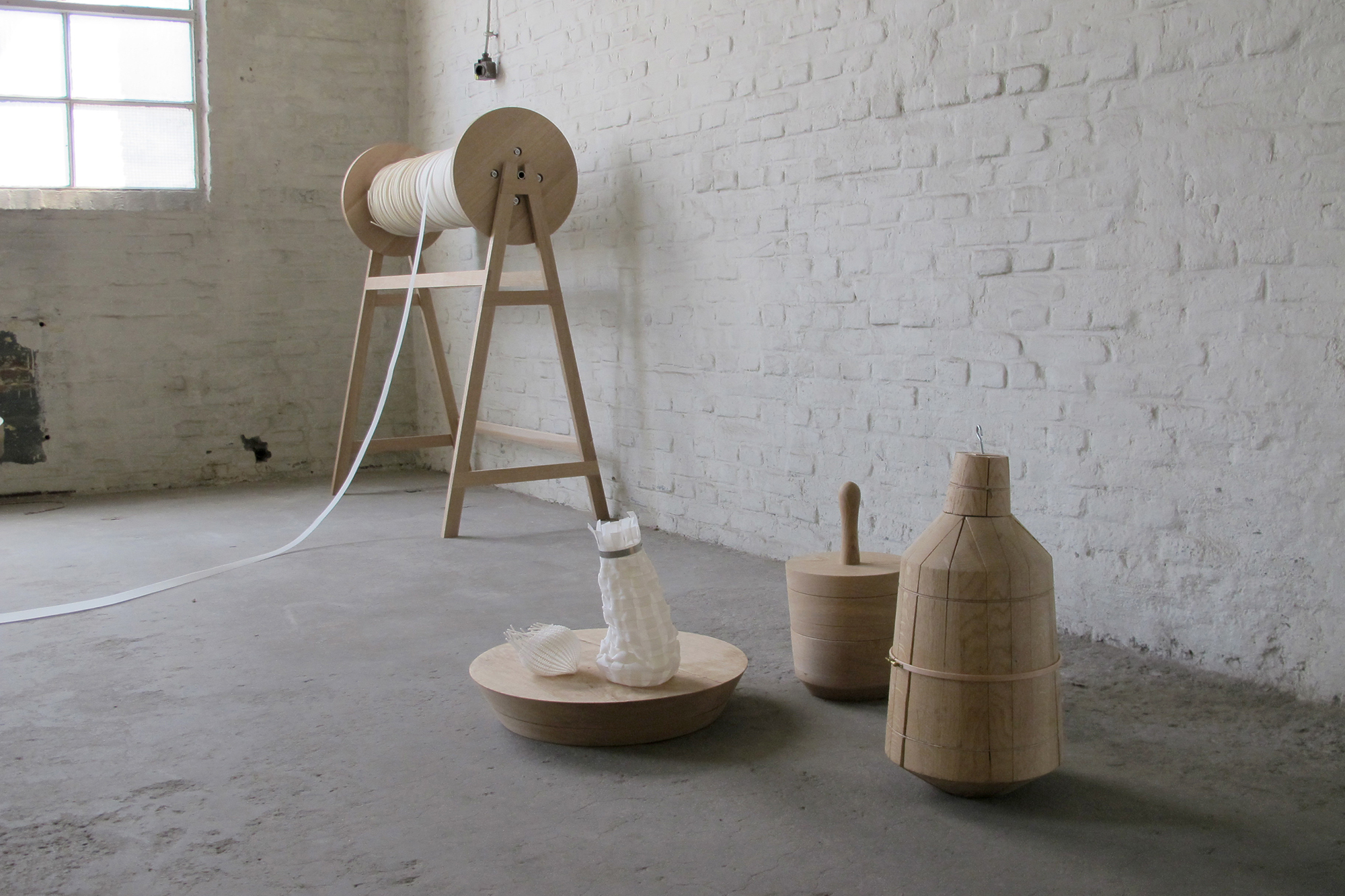

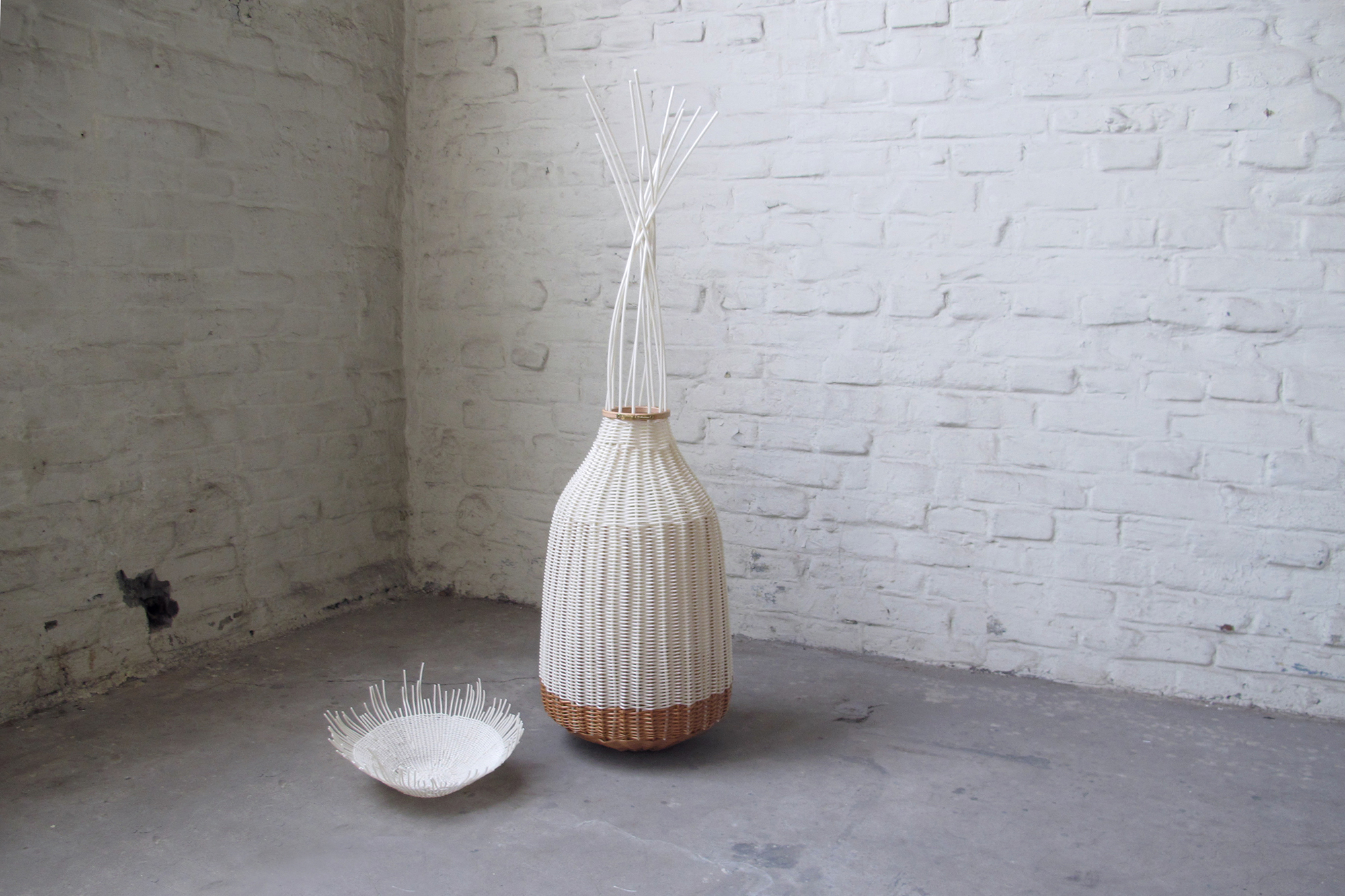

Trade Union
Basket Series
“Trade Union” uses the starch-based plastic Solanyl as a link between industrial production and handcraft. The plastic–which is industrially produced, but naturally biodegradable–is mechanically extruded into simple profiles. These profiles are then used to craft a family of woven vessels using traditional methods. Revisiting tradition using an industrially produced “natural” material suggests a new relationship between industry and craft; a marriage of industrial chemistry and traditional knowledge that allows for a more flexible system of production and design. Meldon Plastics and Dutch basket maker Esme Hofman act as collaborators, bringing their skills and expertise to the project.
2010
Available Through: Earnest Studio
Concept: Rachel Griffin
Design and Development: Rachel Griffin
Photography: Rachel Griffin
Press Downloads
Permalink



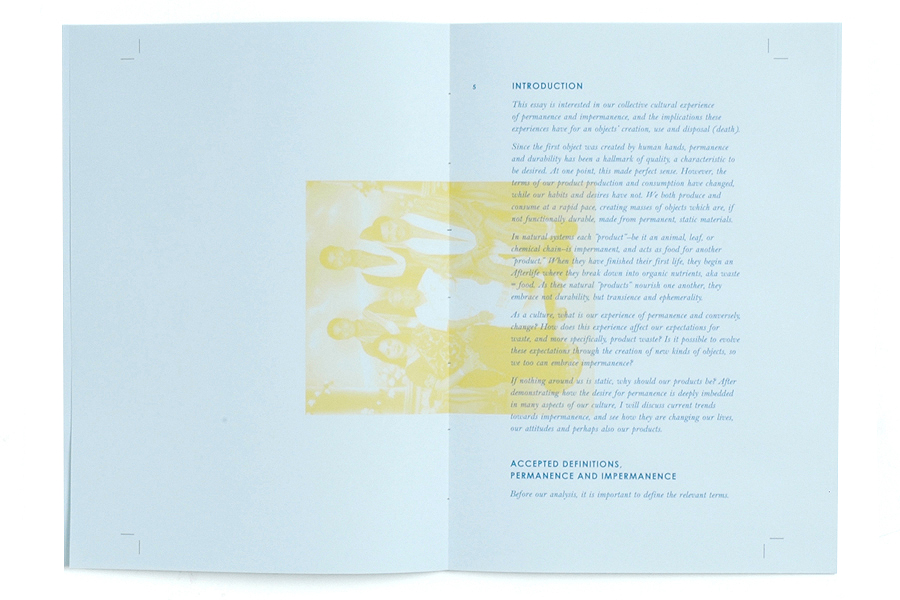

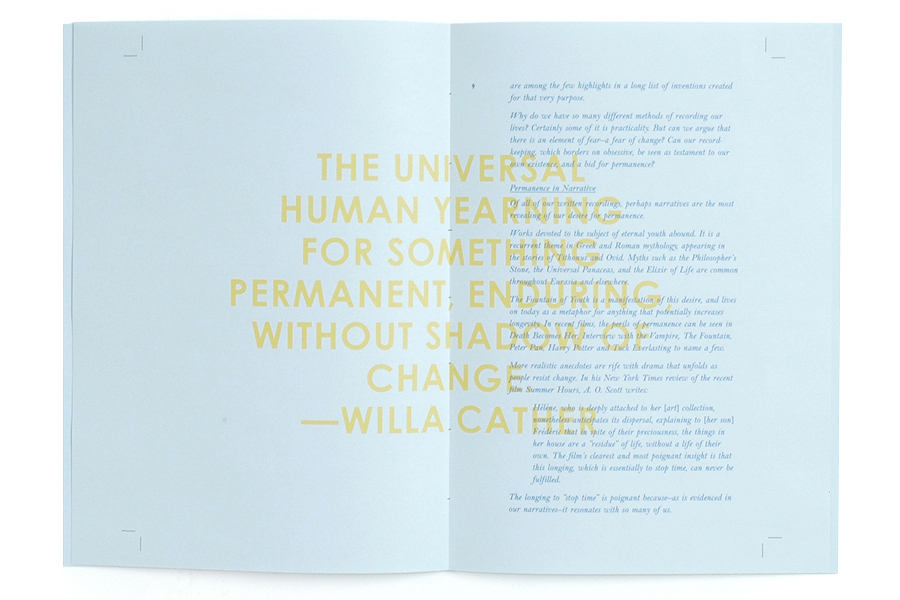




The Afterlife
Essay and Book
A design for an essay discussing the subject of impermanence. Everything around us–and including us–is always changing. If everything is dynamic, why are our objects designed to be static? The design of the book reflects this thesis in the in-process style of binding and faded imagery.
2009
Concept: Rachel Griffin
Design and Development: Rachel Griffin
Press Downloads
Permalink